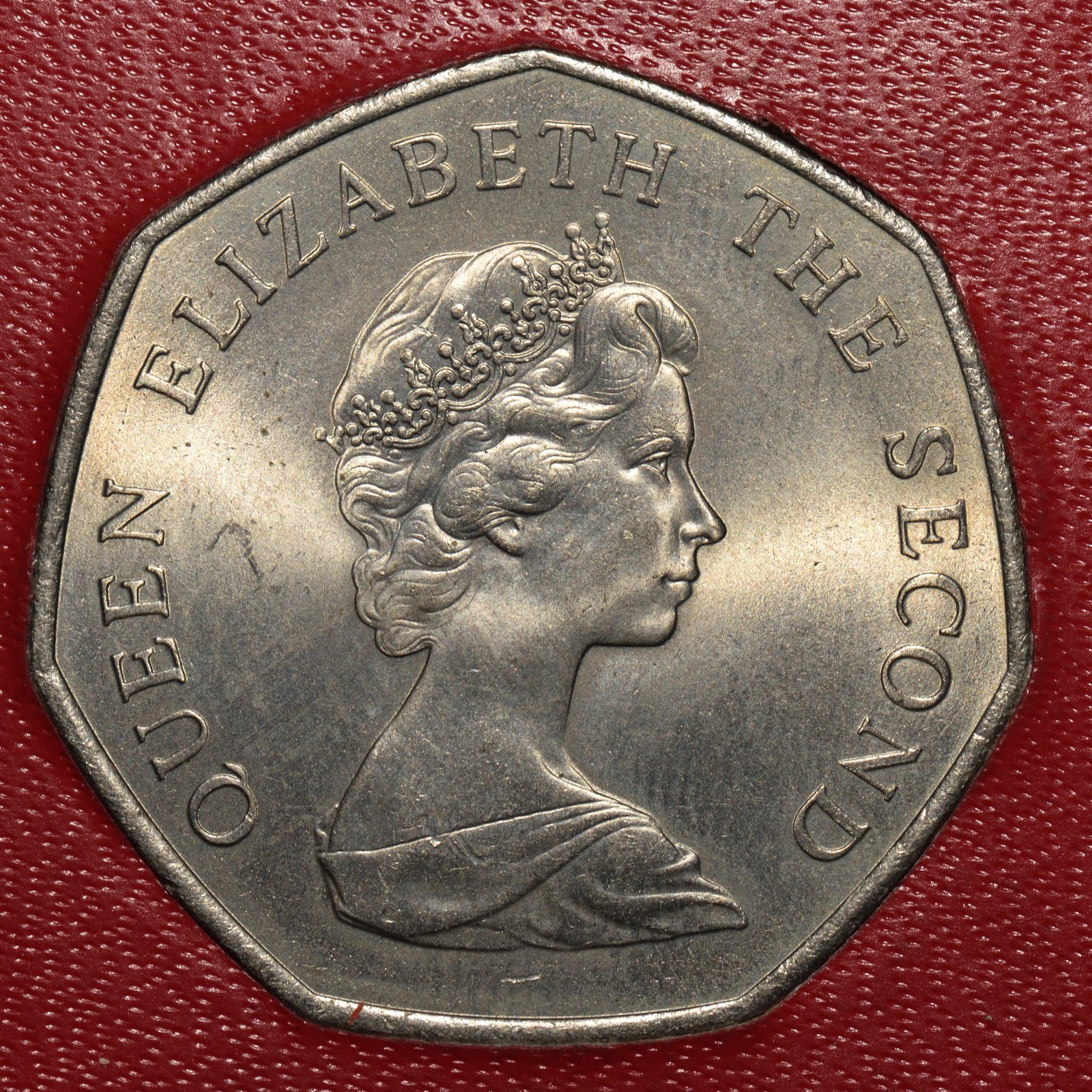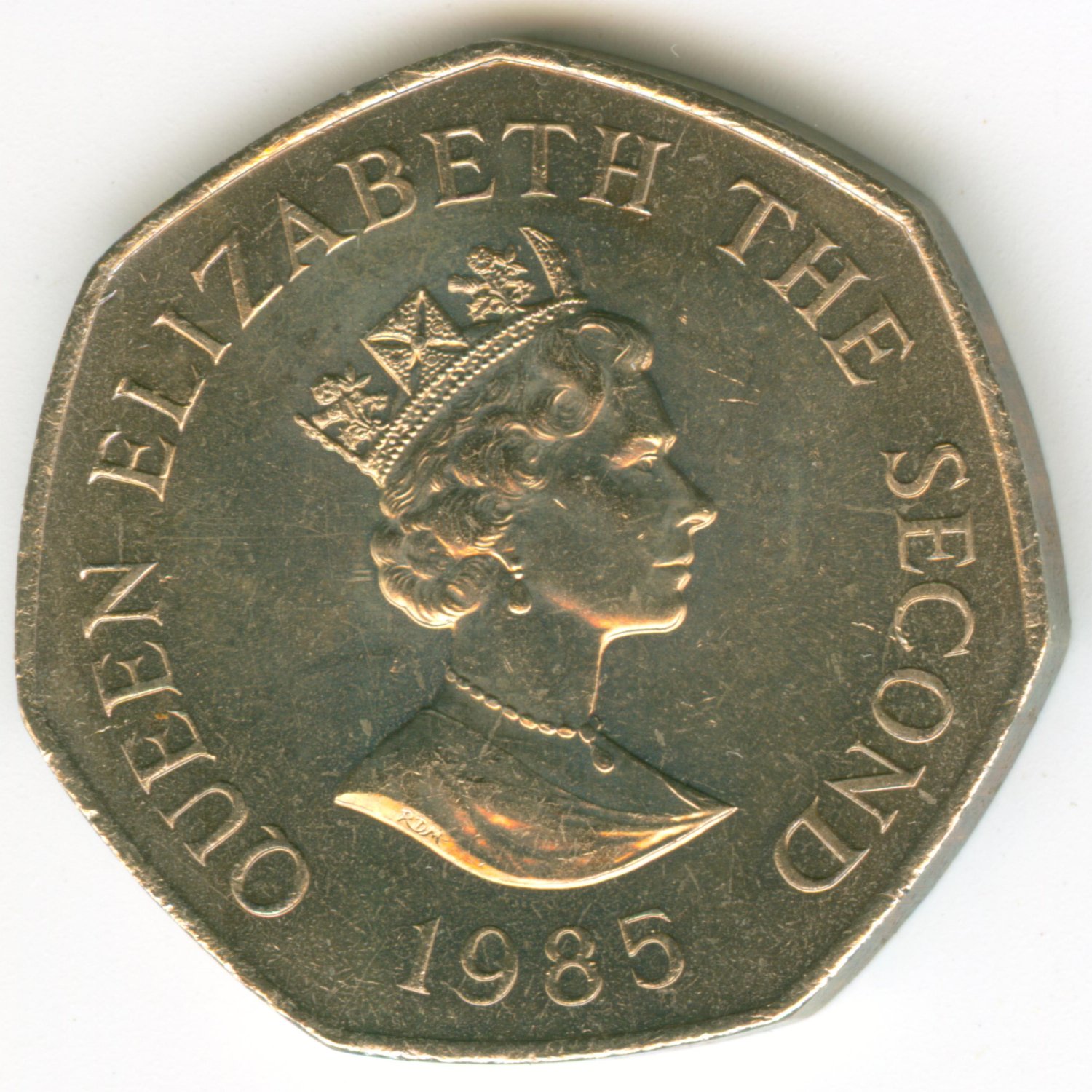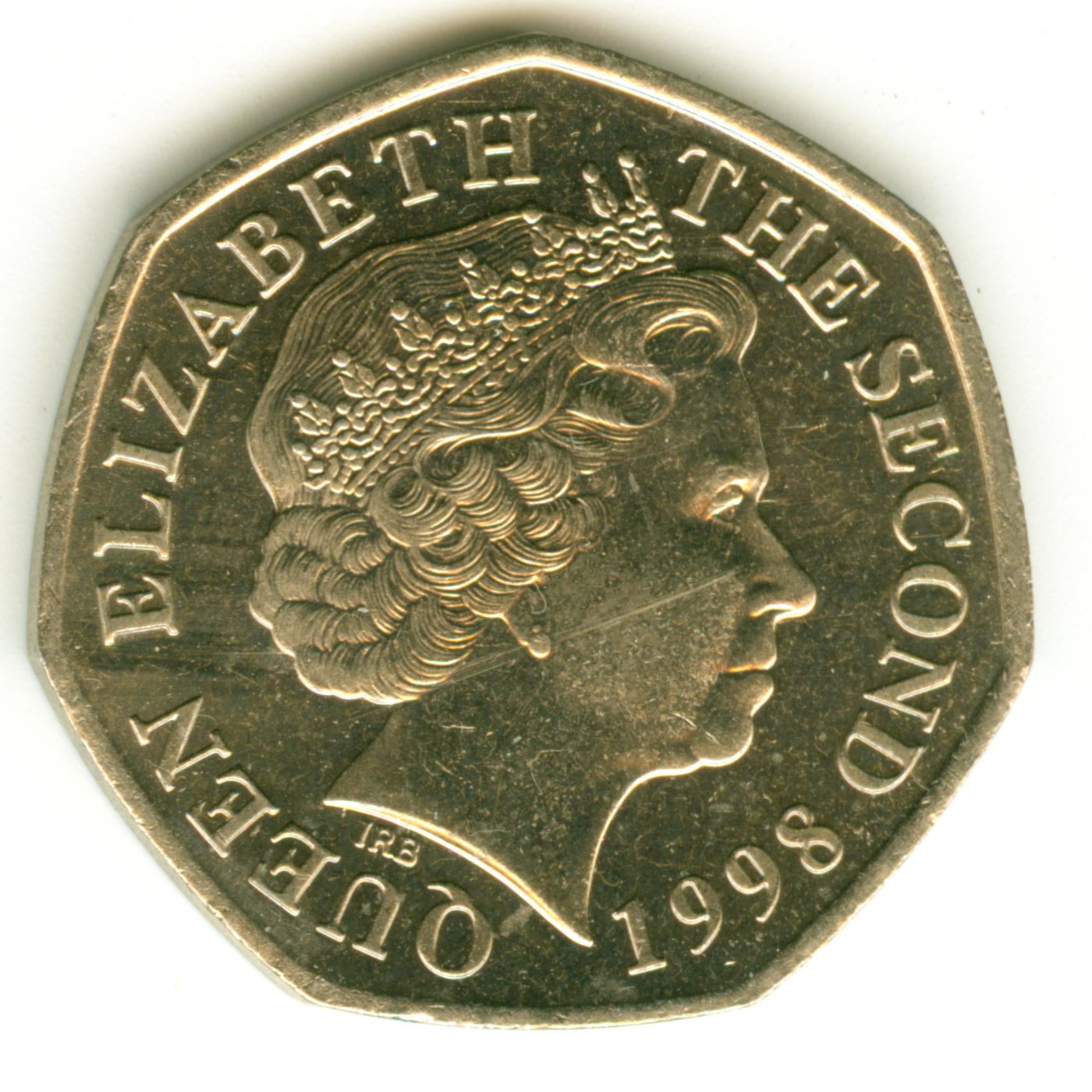January 19, 2024
Part 9: Circulating Decimal Coinage
| The Current Decimal Coinage |
|---|
 |
The first major change in Jersey's coinage designs in 140 years took place in 1983.
Previously the Seal of the Bailiwick had been shown on a common reverse for all denominations. Now representations of landmarks of Jersey
history are depicted. The different designs help to distinguish the different values of the coins.
| Denomination |
Period |
Landmark |
Some Initial Designs |
A Letter by Ian Monins, States Coinage Advisor,
to John Kelly of the Royal Mint |
| One Penny |
Napoleonic Wars |
Le Hocq Watch Tower
Used Against Napoleon's Troops |
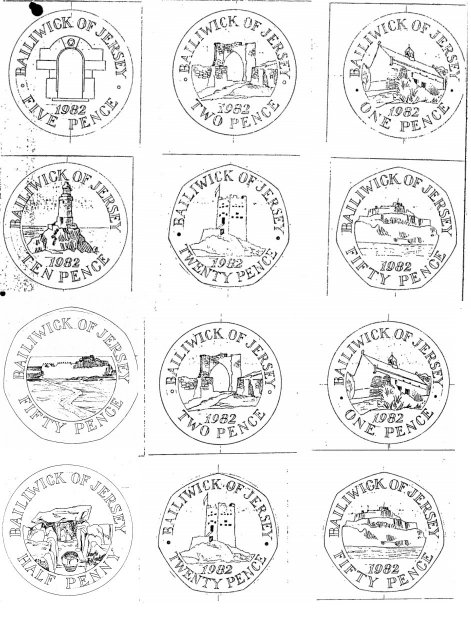 |
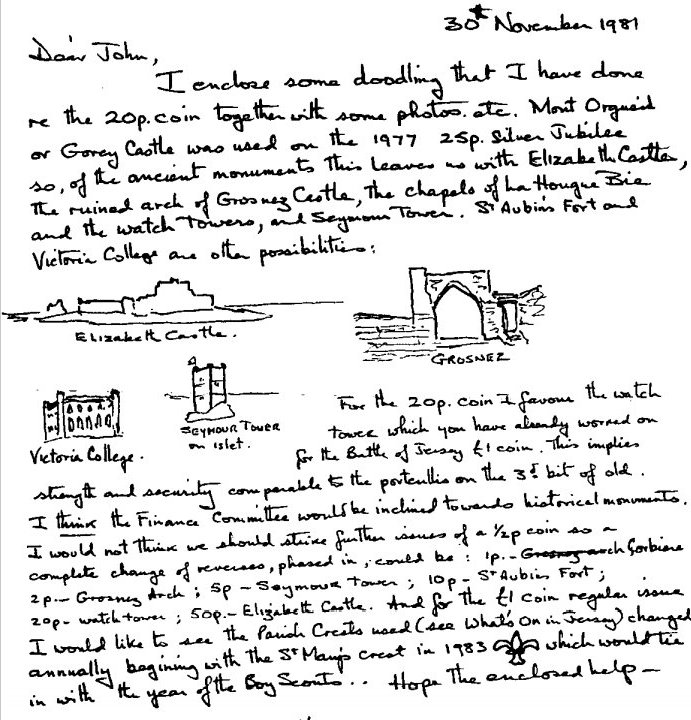 |
| Two Pence |
Dark Ages |
L 'Hermitage
the Cell of St. Helier at Elizabeth Castle |
| Five Pence |
Tudor Times |
Seymour Tower
a Sea-Girt Defense from Invasion |
| Ten Pence |
Pre-History |
The Dolmen
a Neolithic Tomb at Faldouet |
| Twenty Pence |
Victorian Age |
La Corbiere Lighthouse
the First Lighthouse Made of Concrete |
| Fifty Pence |
Middle Ages |
The Gatehouse
of Grosnez Castle |
| Denomination |
Period |
Landmark |
| One Penny |
Napoleonic Wars |
Le Hocq Watch Tower
Used Against Napoleon's Troops |
| Two Pence |
Dark Ages |
L 'Hermitage
the Cell of St. Helier at Elizabeth Castle |
| Five Pence |
Tudor Times |
Seymour Tower
a Sea-Girt Defense from Invasion |
| Ten Pence |
Pre-History |
The Dolmen
a Neolithic Tomb at Faldouet |
| Twenty Pence |
Victorian Age |
La Corbiere Lighthouse
the First Lighthouse Made of Concrete |
| Fifty Pence |
Middle Ages |
The Gatehouse
of Grosnez Castle |
Some Initial Designs

A Letter by Ian Monins, States Coinage Advisor,
to John Kelly of the Royal Mint |
 |
Ian Monins, a Jersey numismatist and an advisor to Jersey's Finance and Economics Committee, heavily influenced the reverse designs
of the current circulating coinage.
Things to note about this series:
A Note About Mintage Figures
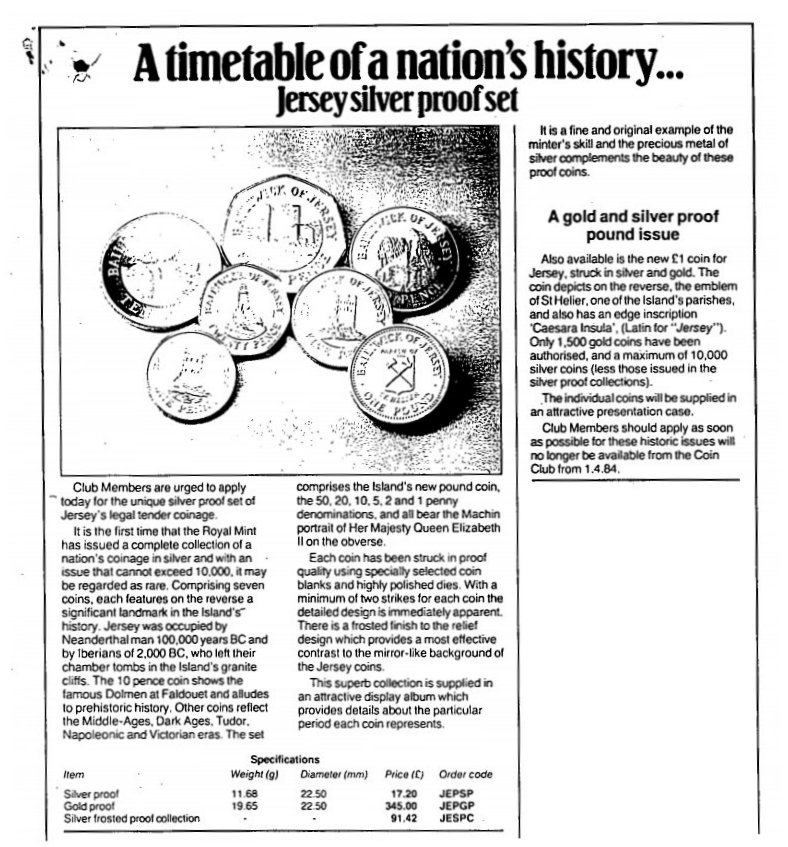
An Ad Appearing in the Royal Mint's Coin Club "Bulletin"
for the 1983 Coinage
|
It has been my experience that various sources will report a different mintage for the same coin and year.
These differences have occurred for a variety of reasons. One is that some people have interpreted 'minting' to have occurred at different points
during the coinage process. For example, a coin might be deemed 'minted' as follows:
- the date a coin is physically struck
- the date the coinage was ordered
- the date on the coinage
Another point of confusion is that unlike the 19th century, coin orders can be made multiple times in one year.
For example, the 1984 one penny coin had two orders, both of 500,000. Thus, the total mintage is 1,000,000.
There can at times be a significant lag between the order of a coin, and the date coins are struck.
Furthermore, if a small number of coins are ordered it might not be cost effective to commission a new die with an updated year.
So, what can happen is a coin with one date can actually be 'minted' over several years. This is the case for the 2012 50p coins.
Another important question to ask is "Do we take into account the number of coins returned to the mint that are scrapped?"
The answer is "Absolutely, if possible."
As noted below, sometimes we know exactly the date and the number of coins returned while other times we only have an estimate of the number returned.
For instance, in early 1986 Jersey returned approximately 200,000 half penny coins for scrap.
Collector sets have similar problems. If they sell well, more are made. If not, the orders are withdrawn. For example, the final numbers are 7,800 for the 1980 proof set
and 6,000 for the 1981 proof set.
Therefore what I have done is try to determine the mintage statistics using various sources and adjusted them using the Royal Mint documents. All is this is documented and
can be verified thru the use of the Royal Mint documents and the Royal Mint Annual Reports.
|
1968 - 1997 Arnold Machin Portrait
To help the new decimal coins stand out from the older currency, a new portrait of The Queen was commissioned. Designed by Arnold Machin RA, the new portrait showed The Queen wearing a tiara instead of a wreath. Like Mary Gillick before him, Machin avoided using a couped portrait cut off by the neck which had been the norm on coins issued earlier in the century.
You might ask, "Why the slight change starting in 1983?" The banking industry request a change so that it would facilitate the sorting of United
Kingdom coins prior to the them being sent back. They wanted both the obverse and reverse sides of the Jersey coins to be clearly distinguishable.
See pages 284-286 in the Royal Mint document MINT-35-JC-Z.pdf for a discussion about this topic.
1985 Raphael Maklouf Portrait
The 1985 50 pence coin featured a royal portrait by the sculptor Raphael Maklouf. The portrait was couped and showed The Queen wearing the royal diadem, which she normally wears on her way to and from the State Opening of Parliament. If you look closely you can see the artist's initials,
RDM, at the bottom of The Queen's neck. Maklouf included his middle initial, D for David, to make sure that his initials wouldn't be seen as a reference to The Royal Mint.
1998 - Preset Ian Rank-Broadley FRBS Portrait
The next portrait is the work of highly respected sculptor Ian Rank-Broadley FRBS. Invited to participate in a competition to design a new royal portrait in 1996 his selected work introduced a greater degree of realism. On the release of the new effigy in early 1998,
the design depicted a portrait of a subject that in the artist's own words, needed no flattery.
Half New Penny
(click on image to enlarge) |
|---|
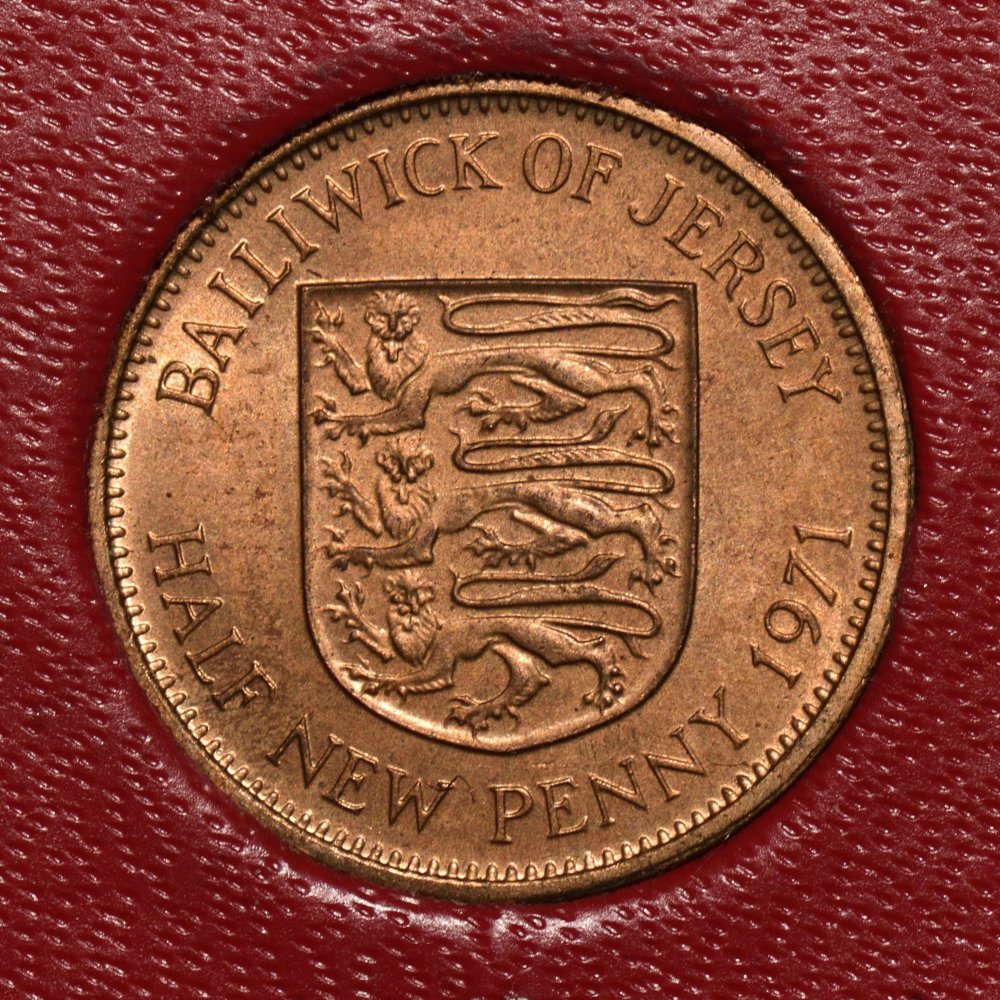 |
YEAR KM mintage diameter
1971 29 4,000,000 17.14
1980 200,000
Things to note about this series:
- For the 1980 coins, see the Royal Mint documents MINT-34-T3-Z.pdf
and MINT-34-TX-Z.pdf
for information concerning the mintage figures and designs.
- An additional 7,800 pieces were minted as a part of a 1980 proof set, which was struck by Birmingham Mint Pressings Limited.
See the Royal Mint document MINT-34-T5-Z.pdf for details.
- An entry in the Royal Mint document MINT-35-CRH-Z.pdf states that 3,000,000 coins
were minted in 1970 and 1971 along with another 1,000,000 in 1977 and 1978.
- These coins were no longer legal tender after February 18, 1985.
- See the Royal Mint documents MINT-35-CRH-Z.pdf for information concerning the return of these coins to the Royal Mint for scrap.
| 1971 Half New Penny Statistics |
| Date |
Quantity |
| 1970 |
3,000,000 |
| 1977 |
1,000,000 |
|
| 1980 Half New Penny Statistics |
| Work Order |
Date |
Quantity |
| 562 |
February 19, 1980 |
200,000 |
|
Half Penny
(click on image to enlarge) |
|---|
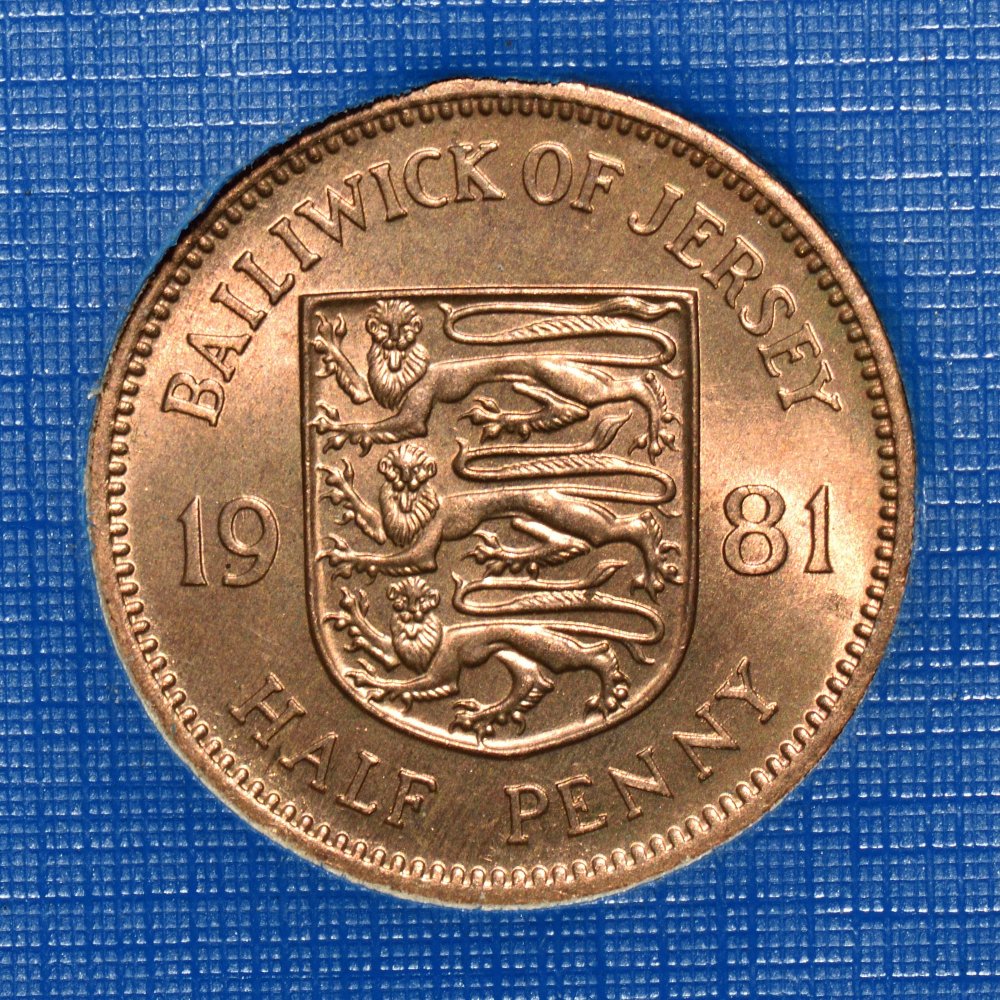 |
YEAR KM mintage diameter
1981 45 50,000 17.14
Things to note about this series:
- An additional 6,000 coins were minted as a part of a 1981 proof set, which was struck by Birmingham Mint Pressings Limited.
See the Royal Mint document MINT-34-T5-Z.pdf for details.
- See the Royal Mint document MINT-34-T3-Z.pdf for information concerning the mintage figures and designs.
- These coins were no longer legal tender after February 18, 1985.
- See the Royal Mint documents MINT-35-CRH-Z.pdf for information concerning the return of these coins to the Royal Mint for scrap.
| 1981 Half Penny Statistics |
| Work Order |
Date |
Quantity |
| 723 |
March 27, 1981 |
50,000 |
One New Penny
(click on image to enlarge) |
|---|
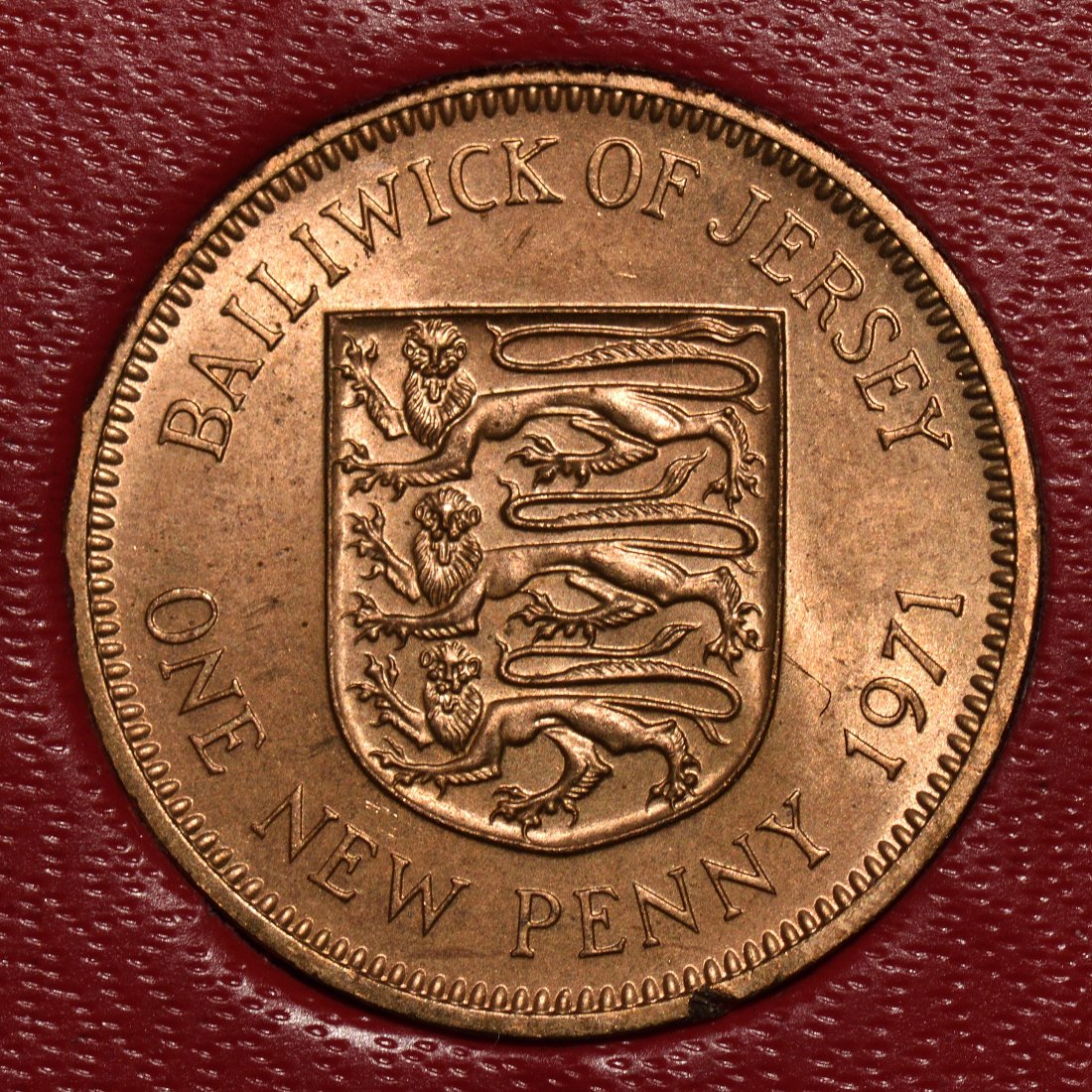 |
YEAR KM mintage diameter
1971 30 4,500,000 20.32
1980 3,000,000
Things to note about this series:
- The total mintage for 1971 is 4,500,000 pieces. Of these 500,000 coins were minted via Work Order No. 467 dated May 18, 1979.
- An additional 7,800 coins were minted as a part of a 1980 proof set, which was struck by Birmingham Mint Pressings Limited.
See the Royal Mint document MINT-34-T5-Z.pdf for details.
- For the 1980 coins, see the Royal Mint documents MINT-34-T3-Z.pdf and MINT-34-TX-Z.pdf for information concerning the mintage figures and designs.
| 1971 One New Penny Statistics |
| Date |
Quantity |
| 1970 |
4,000,000 |
| 1979 |
500,000 |
|
| 1980 One New Penny Statistics |
| Work Order |
Date |
Quantity |
| 562 |
February 19, 1980 |
3,000,000 |
|
One Penny
(click on image to enlarge) |
|---|
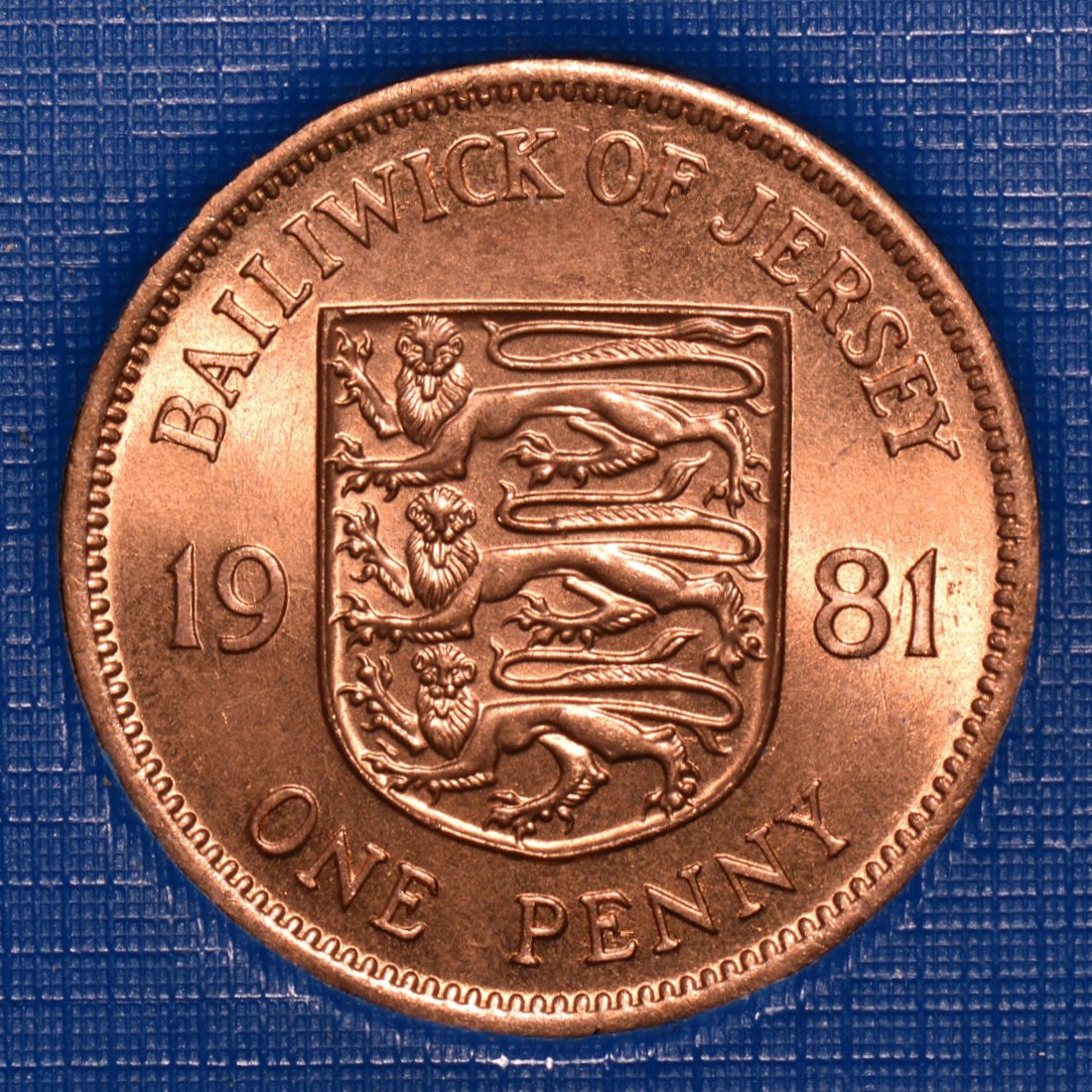 |
YEAR KM mintage diameter
1981 46 50,000 20.32
Things to note about this series:
- An additional 6,000 coins were minted as a part of a 1981 proof set, which was struck by Birmingham Mint Pressings Limited.
See the Royal Mint document MINT-34-T5-Z.pdf for details.
- See the Royal Mint document MINT-34-T3-Z.pdf for information concerning the mintage figures and designs.
| 1981 One Penny Statistics |
| Work Order |
Date |
Quantity |
| 723 |
March 27, 1981 |
50,000 |
One Penny
Le Hocq Watch Tower, St. Clement
(click on image to enlarge) |
|---|
 |
|
Silver Proof One Penny
Le Hocq Watch Tower, St. Clement
(click on image to enlarge) |
|---|
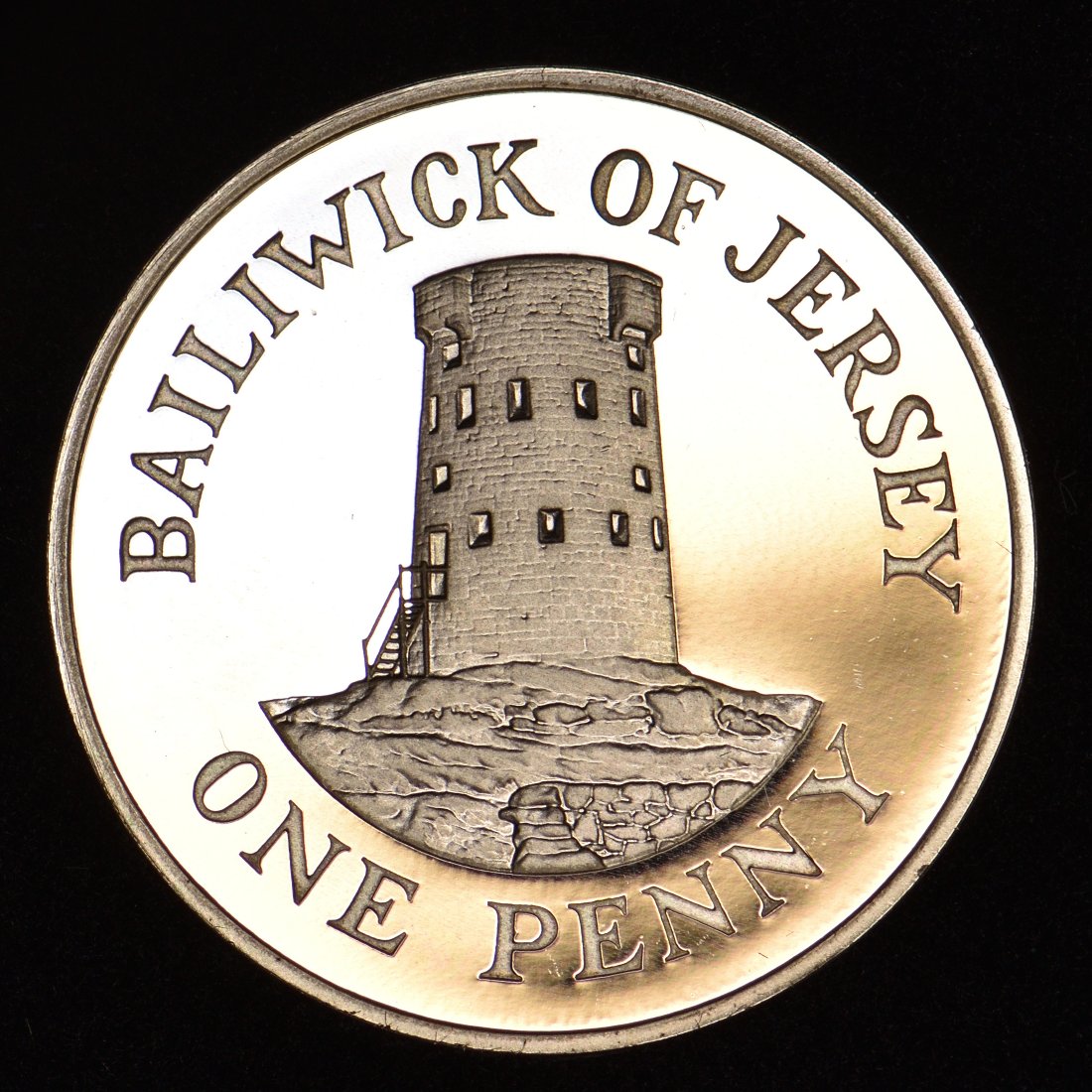 |
|
YEAR KM mintage diameter
1983 54.1 500,000 20.32
1984 1,000,000
1985 1,000,000
1986 2,000,000
1987 1,500,000
1988 1,000,000
1989 1,500,000
1990 2,000,000
1992 6,000
1994 54.2 2,000,000
1997 320,000
1998 103 6,350,000
2000 1,500,000
2001 1,500,000
2002 1,520,000
2003 1,575,000
2005 1,030,000
2006 1,630,000
2008 4,800,000
2012 3,580,000
2014 720,000
2016 8,400,000
The Le Hocq Watch Tower was built about 1781 and predated the action at Mortella Point, Corssica (1794). Thus the Watch Tower
built under general Conway for the defence of the Island against France is not a Matello Tower, which is squatter and lacks the parapet projections.
Things to note about this series:
- The reverse design is by Robert Lowe.
- The Royal Mint document MINT-35-CRQ-Z.pdf discusses the new coinage designs.
- The Royal Mint document MINT-35-CRM-Z.pdf concerns the 1983 and 1984 mintage.
- The Royal Mint document MINT-35-CRN-Z.pdf concerns the 1985, 1986, and 1987 mintages.
- The Royal Mint document MINT-35-CR2-Z.pdf concerns the 1987 mint set.
- The Royal Mint document MINT-36-CGP-Z.pdf concerns the 1988, 1989 and 1990 mintages.
- A total of 5005 1983 silver proof sets were also minted. Later in 1990, 3986 sets were melted for silver.
Thus the total mintage of the 1983 silver proof set is 1019.
See the Royal Mint documents MINT-35-CRR-Z.pdf
and MINT-36-CGP-Z.pdf for details.
- The 1992 coins were available only in mint sets. The Royal Mint document MINT-36-CG4-Z.pdf concerns the 1992 mint set.
- Starting in 1994, the composition is now copper plated steel instead of bronze.
- The 1998 dated coins had 1,500,000 struck in both 1999 and 2000. See the Royal Mint document MINT-43-7-Z.pdf for details.
- The 2012 dated coins were minted in 2011 thru 2015.
- The 2016 dated coins were minted in 2016, 2017, and 2018.
- For recent mintage information see the States of Jersey documents "Coin in circulation from year 2000"
and "Coins minted from 2013 to March 2018 Summary".
| 1983 One Penny Statistics |
| Work Order |
Date |
Quantity |
| 20 |
February 10, 1983 |
500,000 |
|
| 1988 One Penny Statistics |
| Work Order |
Date |
Quantity |
| 866 |
August 3, 1988 |
1,000,000 |
|
| 1998 One Penny Statistics |
| Work Order |
Date |
Quantity |
| 216 |
June 9, 1999 |
1,500,000 |
| 380 |
June 30, 2000 |
1,500,000 |
|
| 1985 One Penny Statistics |
| Work Order |
Date |
Quantity |
| 278 |
February 18, 1985 |
1,000,000 |
|
| 1989 One Penny Statistics |
| Work Order |
Date |
Quantity |
| 955 |
January 20, 1989 |
1,500,000 |
|
| 2012 One Penny Statistics |
| Date |
Quantity |
| 2011 |
240,000 |
| 2012 |
600,000 |
| 2013 |
960,000 |
| 2014 |
1,200,000 |
| 2015 |
500,000 |
|
| 1986 One Penny Statistics |
| Work Order |
Date |
Quantity |
| 456 |
February 25, 1986 |
1,000,000 |
| 526 |
September 8, 1986 |
1,000,000 |
|
| 1990 One Penny Statistics |
| Work Order |
Date |
Quantity |
| 139 |
January, 1990 |
1,000,000 |
| 286 |
October 8, 1990 |
1,000,000 |
|
| |
| 1987 One Penny Statistics |
| Work Order |
Date |
Quantity |
| 587 |
January 28, 1987 |
1,500,000 |
|
| 2016 One Penny Statistics |
| Date |
Quantity |
| 2016 |
360,000 |
| 2017 |
6,960,000 |
| Jan to Mar 2018 |
1,080,000 |
|
|
Two New Pence
(click on image to enlarge) |
|---|
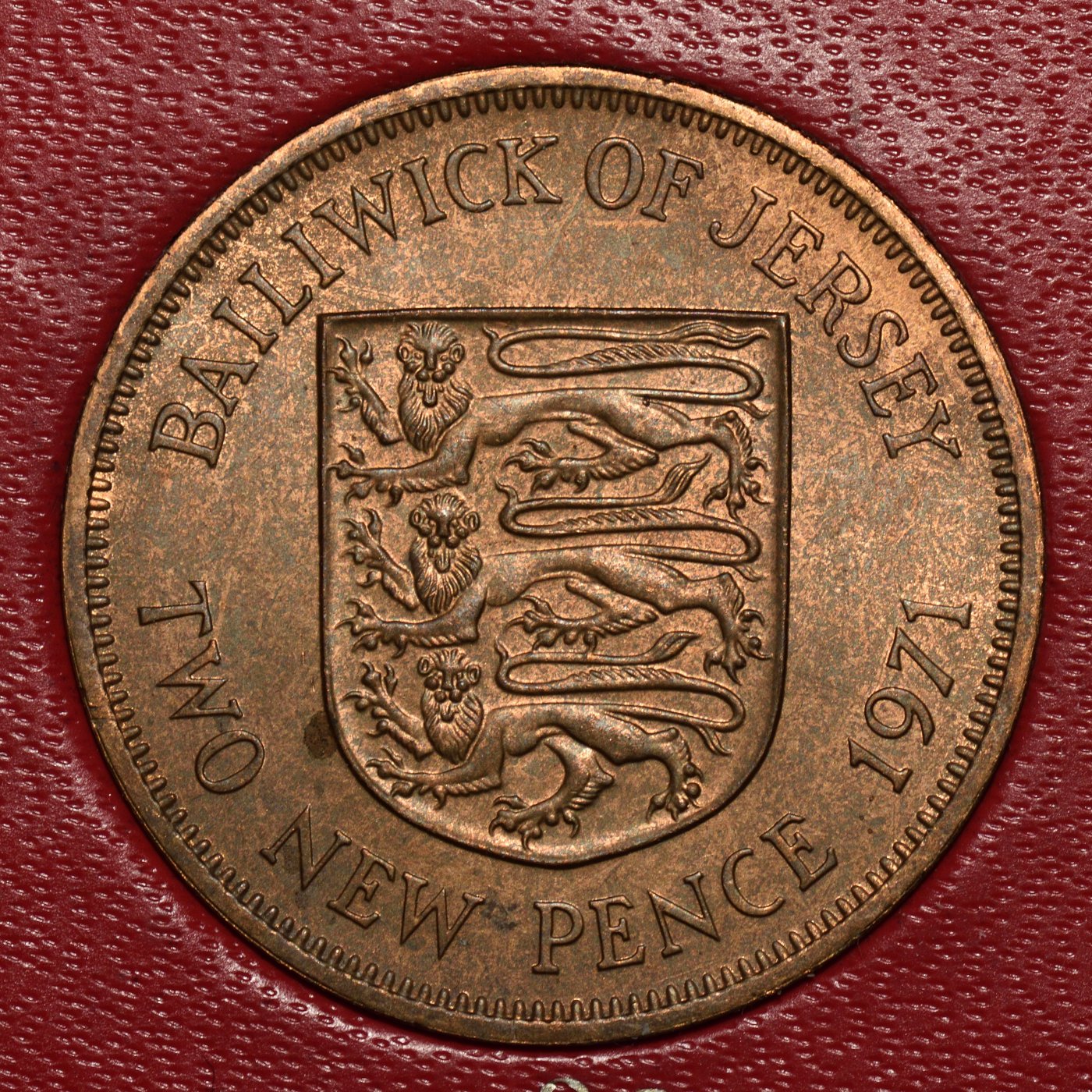 |
YEAR KM mintage diameter
1971 31 2,225,000 25.91
1975 3,250,000
1980 2,030,000
Things to note about this series:
- The total mintage for 1975 is 3,250,000 pieces. 750,000 coins were minted in 1975.1
An additional 250,000 coins were minted via Work Order No. 467 dated May 18, 1979.
- Although Jersey order 2,000,000 two pence coins in 1980, an over production of 30,000 coins resulted in a total mintage of 2,030,000.
- An additional 7,800 coins were minted as a part of a 1980 proof set, which was struck by Birmingham Mint Pressings Limited.
See the Royal Mint document MINT-34-T5-Z.pdf for details.
- For the 1980 coins, see the Royal Mint documents MINT-34-T3-Z.pdf and MINT-34-TX-Z.pdf
for information concerning the mintage figures and designs.
- See the Royal Mint document MINT-33-PG-Z.pdf
for information concerning the the delivery of coins.
| 1971 Two New Pence Statistics |
| Date |
Quantity |
| 1970 |
2,250,000 |
|
| 1975 Two New Pence Statistics |
| Date |
Quantity |
| 1975 |
750,000 |
| 1979 |
250,000 |
|
| 1980 Two New Pence Statistics |
| Work Order |
Date |
Quantity |
| 562 |
February 19, 1980 |
2,000,000 plus an additional 30,000 |
|
Two Pence
(click on image to enlarge) |
|---|
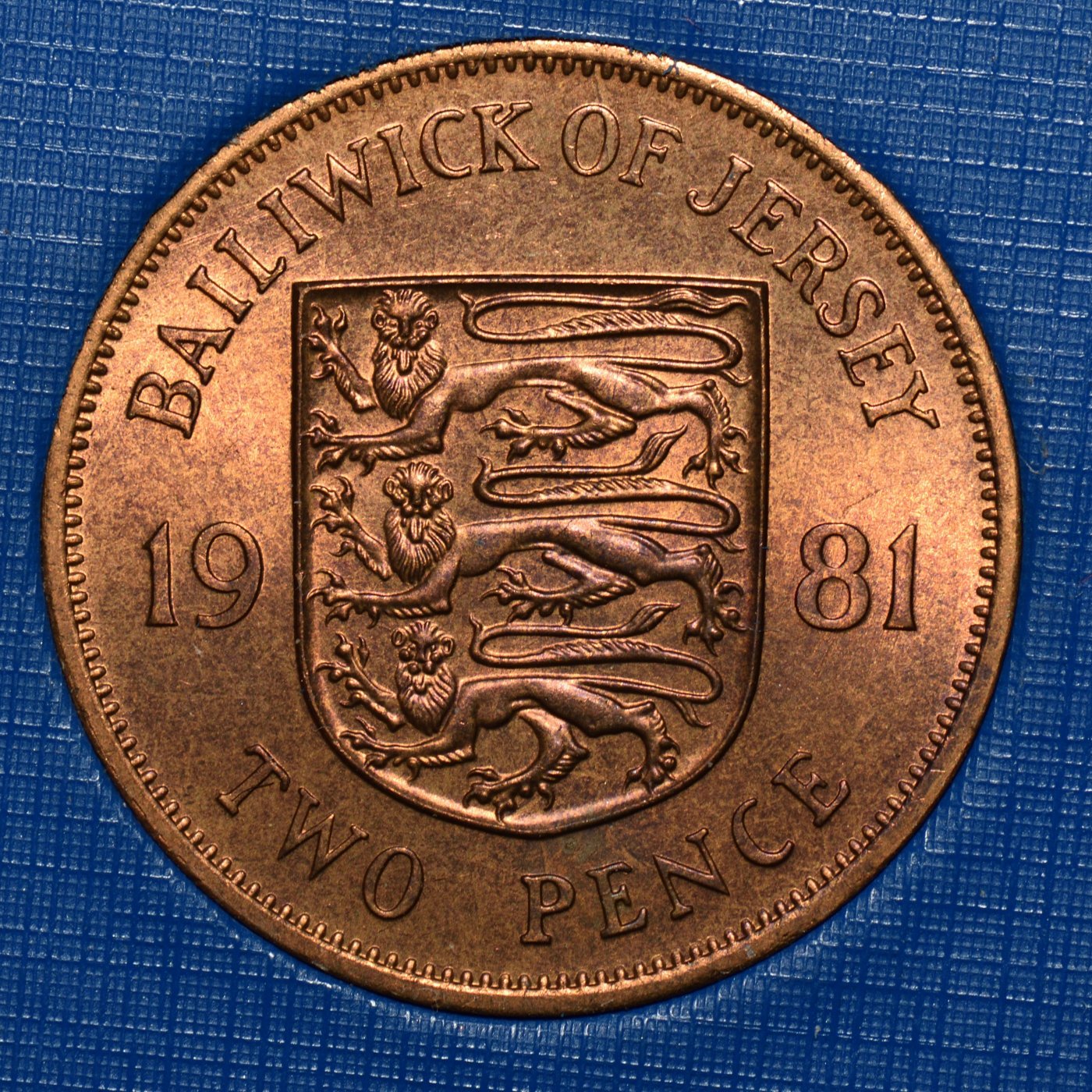 |
YEAR KM mintage diameter
1981 47 1,050,000 25.91
Things to note about this series:
- An additional 6,000 coins were minted as a part of a 1981 proof set, which was struck by Birmingham Mint Pressings Limited.
See the Royal Mint document MINT-34-T5-Z.pdf for details.
- The Royal Mint document MINT-35-CRM-Z.pdf concerns the 1981 mintage.
- See the Royal Mint document MINT-34-T3-Z.pdf for information concerning the mintage figures and designs.
| 1981 Two Pence Statistics |
| Work Order |
Date |
Quantity |
| 723 |
March 27, 1981 |
50,000 |
| 919 |
June 30, 1982 |
1,000,000 |
Two Pence
L'Hermitage, St. Helier
(click on image to enlarge) |
|---|
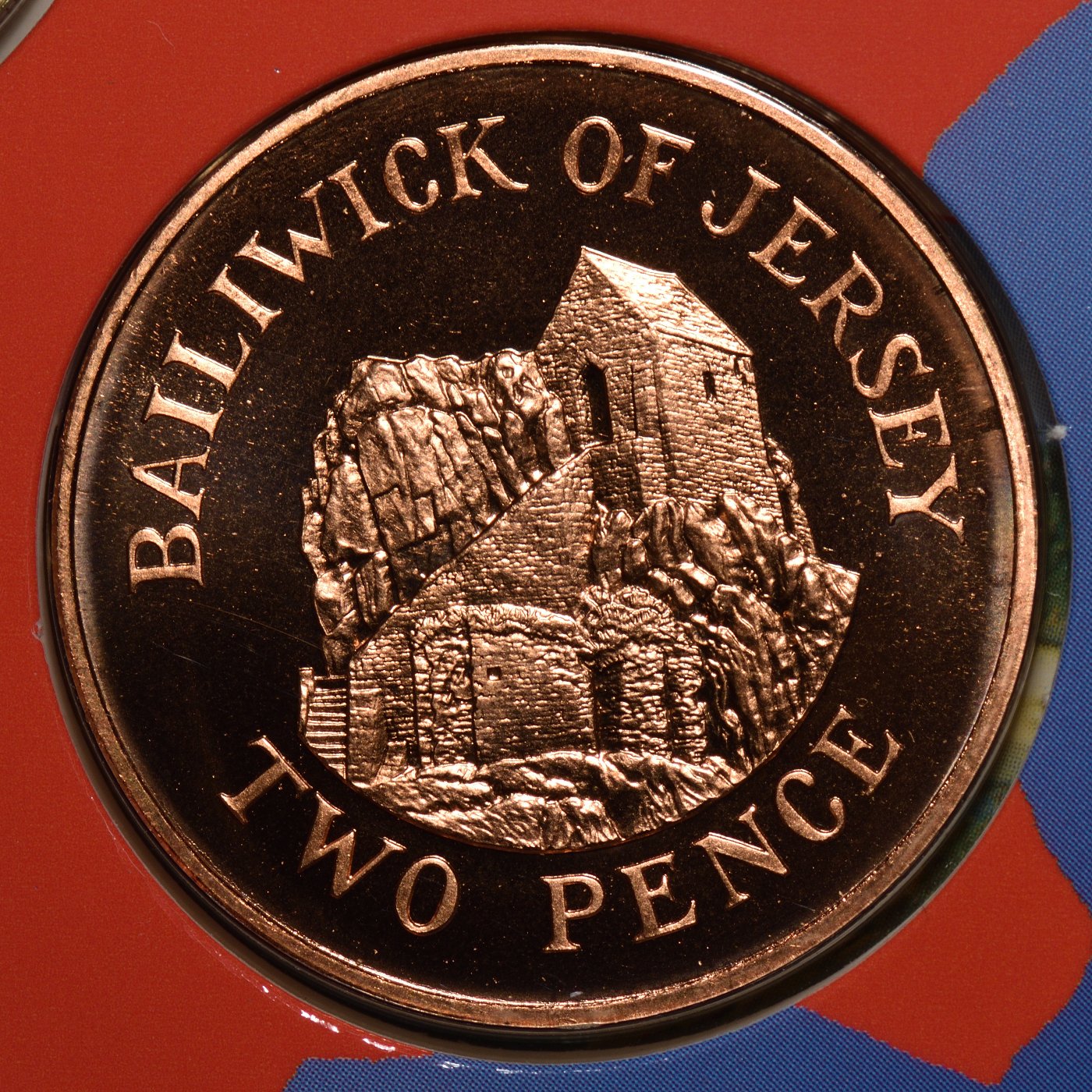 |
|
Silver Proof Two Pence
L'Hermitage, St. Helier
(click on image to enlarge) |
|---|
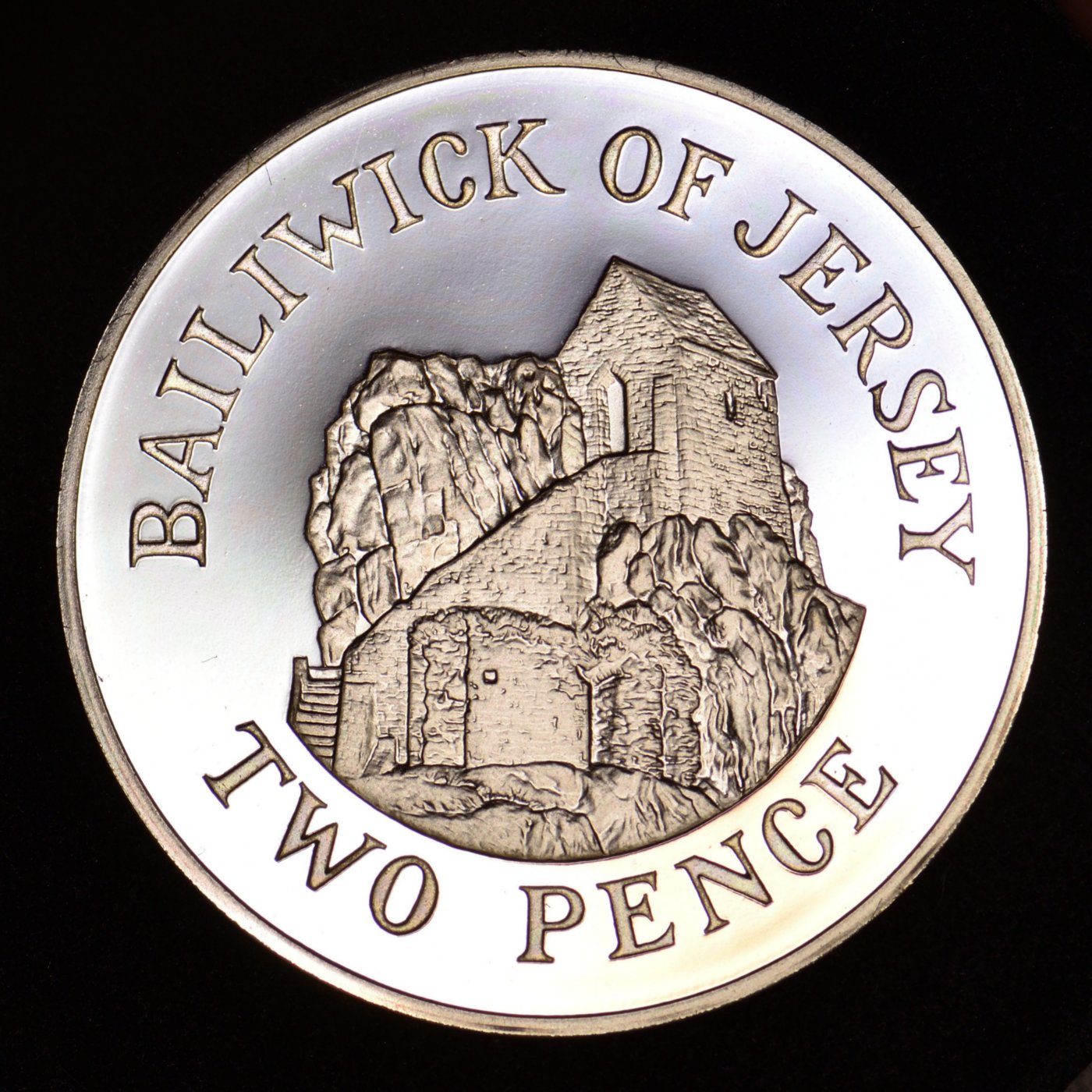 |
|
YEAR KM mintage diameter
1983 55.1 800,000 25.91
1984 750,000
1985 250,000
1986 1,000,000
1987 2,000,000
1988 750,000
1989 1,000,000
1990 2,600,000
1992 2,250,000
1997 55.2 5,500
1998 104 3,750,000
2002 1,259,000
2003 10,000
2005 400,000
2006 1,200,000
2008 2,467,000
2012 720,000
2014 360,000
2016 720,000
Saint Helier lived a life of prayer in a cave on the top of Hermitage Rock for 15 years until 555 AD when he was beheaded by Norman pirates.
He is the patron saint of Jersey and his feast day is 16th July.
Things to note about this series:
- The reverse design is by Robert Lowe.
- The Royal Mint document MINT-35-CRQ-Z.pdf discusses the new coinage designs.
- The Royal Mint document MINT-35-CRM-Z.pdf concerns the 1983 and 1984 mintage.
- The Royal Mint document MINT-35-CRN-Z.pdf concerns the 1985, 1986, and 1987 mintages.
- The Royal Mint document MINT-35-CR2-Z.pdf concerns the 1987 mint set.
- The Royal Mint document MINT-36-CGP-Z.pdf concerns the 1988, 1989 and 1990 mintages.
- A total of 5005 1983 silver proof sets were also minted. Later in 1990, 3986 sets were returned to the mint for their silver.
Thus the total mintage of the 1983 silver proof set is 1019.
See the Royal Mint documents
MINT-35-CRR-Z.pdf
and MINT-36-CGP-Z.pdf for details.
- The Royal Mint document MINT-36-CG4-Z.pdf concerns the 1992 mint set.
- Starting in 1994, the composition of bronze coinage was changed to copper plated steel.
- The 1997 coins were available only in mint sets.
- The 1998 dated coins had 1,250,000 struck in 2000. See the Royal Mint document MINT-43-7-Z.pdf for details.
- The 2012 dated coins were minted in in 2011, 2012, and 2013.
- The 2016 dated coins were minted in 2016 and 2017.
- For recent mintage information see The States of Jersey documents "Coin in circulation from year 2000"
and "Coins minted from 2013 to March 2018 Summary".
|
| 1983 Two Pence Statistics |
| Work Order |
Date |
Quantity |
| 20 |
February 10, 1983 |
800,000 |
|
| 1987 Two Pence Statistics |
| Work Order |
Date |
Quantity |
| 587 |
January 28, 1987 |
2,000,000 |
|
| 1998 Two Pence Statistics |
| Work Order |
Date |
Quantity |
| 35 |
September 28, 1999 |
2,500,000 |
| 380 |
June 30, 2000 |
1,250,000 |
|
| 1984 Two Pence Statistics |
| Work Order |
Date |
Quantity |
| 131 |
December 7, 1983 |
750,000 |
|
| 1988 Two Pence Statistics |
| Work Order |
Date |
Quantity |
| 866 |
August 3, 1988 |
750,000 |
|
| 2012 Two Pence Statistics |
| Date |
Quantity |
| 2011 |
80,000 |
| 2012 |
320,000 |
| 2013 |
320,000 |
|
| 1985 Two Pence Statistics |
| Work Order |
Date |
Quantity |
| 278 |
February 18, 1985 |
250,000 |
|
| 1989 Two Pence Statistics |
| Work Order |
Date |
Quantity |
| 955 |
January 20, 1989 |
1,000,000 |
|
| 1986 Two Pence Statistics |
| Work Order |
Date |
Quantity |
| 456 |
February 25, 1986 |
500,000 |
| 526 |
September 8, 1986 |
500,000 |
|
| 1990 Two Pence Statistics |
| Work Order |
Date |
Quantity |
| 139 |
January, 1990 |
500,000 |
| 229 |
June 21, 1990 |
600,000 |
| 286 |
October 8, 1990 |
1,500,000 |
|
| 2016 Two Pence Statistics |
| Date |
Quantity |
| 2016 |
240,000 |
| 2017 |
480,000 |
|
Five New Pence
(click on image to enlarge) |
|---|
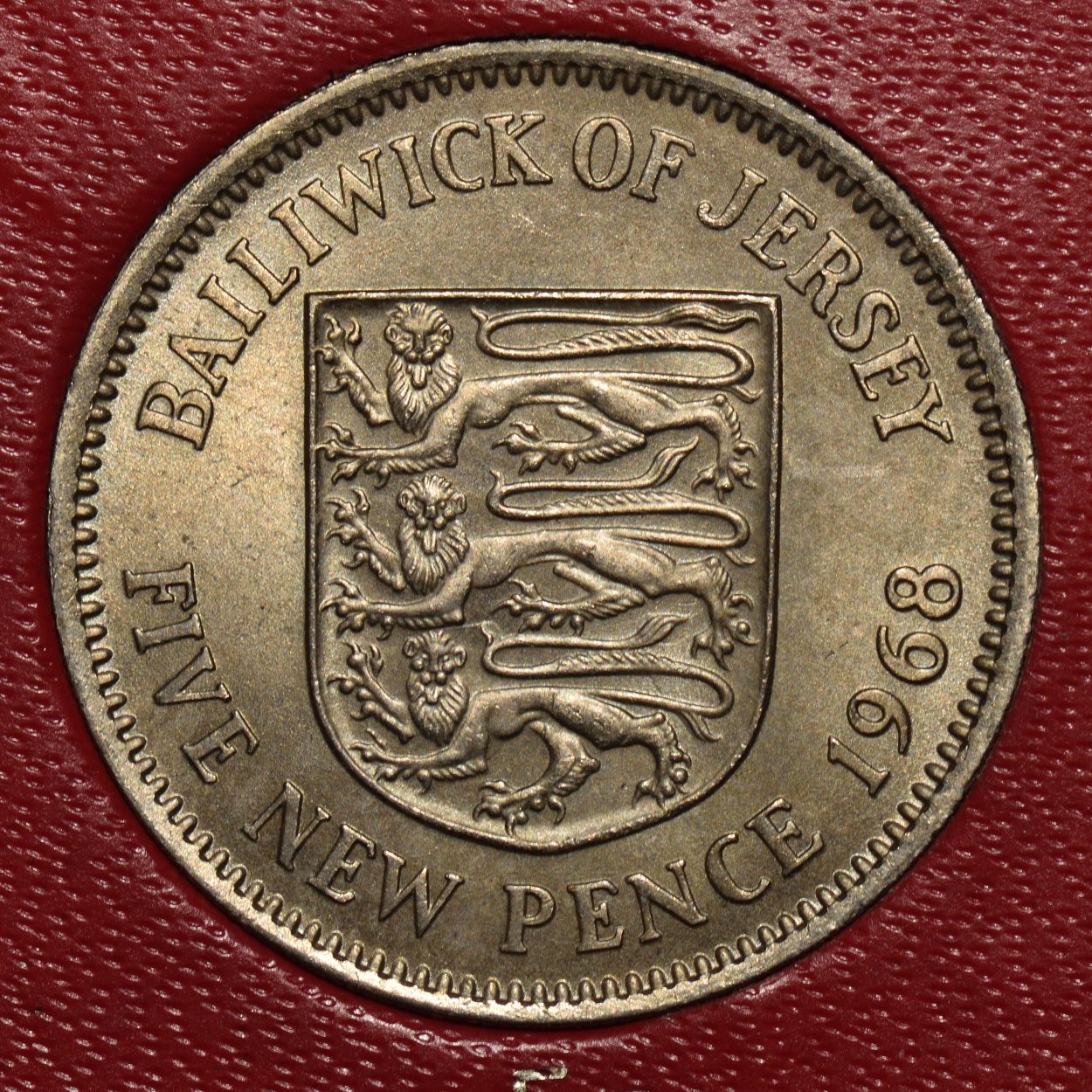 |
YEAR KM mintage diameter
1968 32 2,400,000 23.59
1980 800,000
Things to note about this series:
- Note that for the 1968 issue, the number is the total net mintage.
The original mintage was 3,600,000 but 1,200,000 coins (still in the original mint sealed bags) were returned to the mint in 1975 for scrap.
See the Royal Mint document MINT-33-PH-Z.pdf for more information about this topic.
- Of the coins dated 1968, 600,000 coins were minted via
Work Order No. 467 dated May 18, 1979.
- In February of 1991, 349 boxes of unsorted 5p coins and 16 boxes of Jersey 5p coins were return to the Royal Mint
for scrap. It is estimated that 1,000,000 Jersey 5p coins were scrapped.
See MINT-36-CGP-Z.pdf for details.
- An additional 7,800 coins were minted as a part of a 1980 proof set, which was struck by Birmingham Mint Pressings Limited.
See the Royal Mint document MINT-34-T5-Z.pdf for details.
- For the 1980 coins, see the Royal Mint documents MINT-34-T3-Z.pdf
and MINT-34-TX-Z.pdf
for information concerning the mintage figures and designs.
- These larger diameter coin ceased to be legal tender after December 31, 1990.
| 1968 Five New Pence Statistics |
| Date |
Quantity |
| 1969 |
2,000,000 |
| 1970 |
1,000,000 |
| 1975 |
1,200,000
(returned) |
| 1979 |
600,000 |
|
| 1980 Five New Pence Statistics |
| Work Order |
Date |
Quantity |
| 562 |
February 19, 1980 |
800,000 |
|
Five Pence
(click on image to enlarge) |
|---|
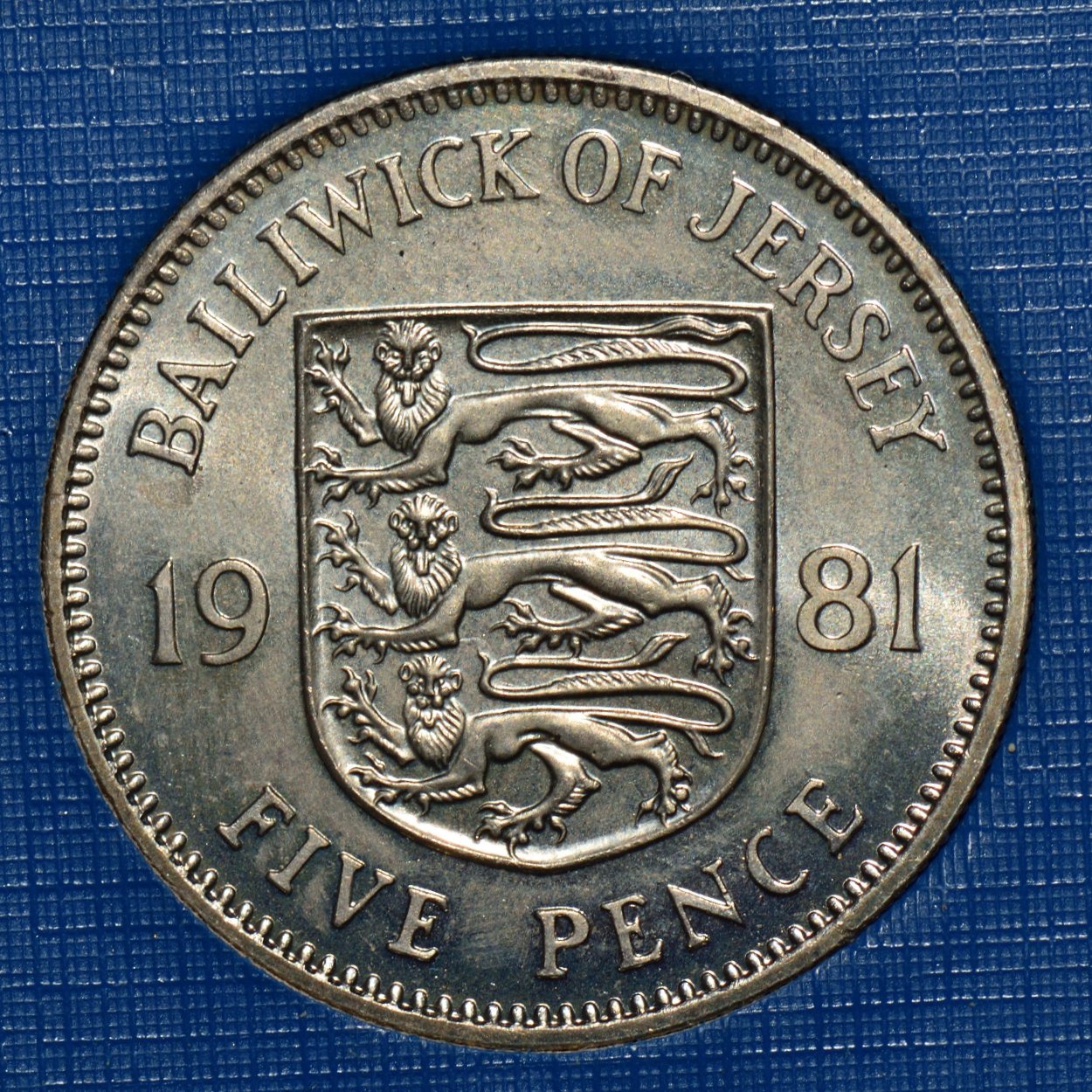 |
YEAR KM mintage diameter
1981 48 50,000 23.59
Things to note about this series:
- An additional 6,000 coins were minted as a part of a 1981 proof set, which was struck by Birmingham Mint Pressings Limited.
See the Royal Mint document MINT-34-T5-Z.pdf for details.
- See the Royal Mint document MINT-34-T3-Z.pdf
for information concerning the mintage figures and designs.
- These larger diameter coin ceased to be legal tender after December 31, 1990.
- In February of 1991, 349 boxes of unsorted 5p coins and 16 boxes of Jersey 5p coins were return to the Royal Mint
for scrap. It is estimated that 1,000,000 Jersey 5p coins were scrapped. See
MINT-36-CGP-Z.pdf for details.
| 1981 Five Pence Statistics |
| Work Order |
Date |
Quantity |
| 723 |
March 27, 1981 |
50,000 |
Five Pence
Seymour Tower, Grouville, L'Avathison
(click on image to enlarge) |
|---|
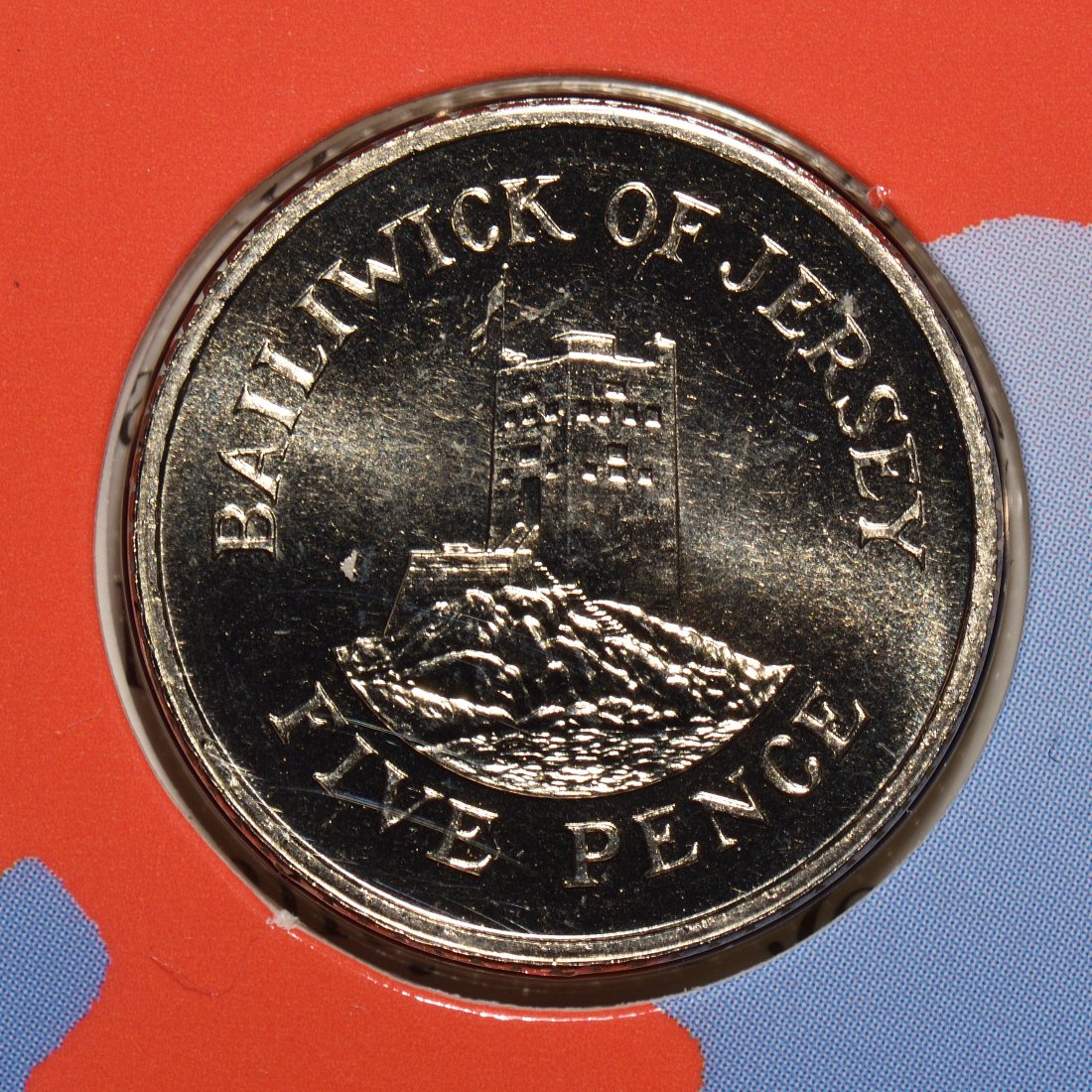 |
|
Silver Proof Five Pence
Seymour Tower, Grouville, L'Avathison
(click on image to enlarge) |
|---|
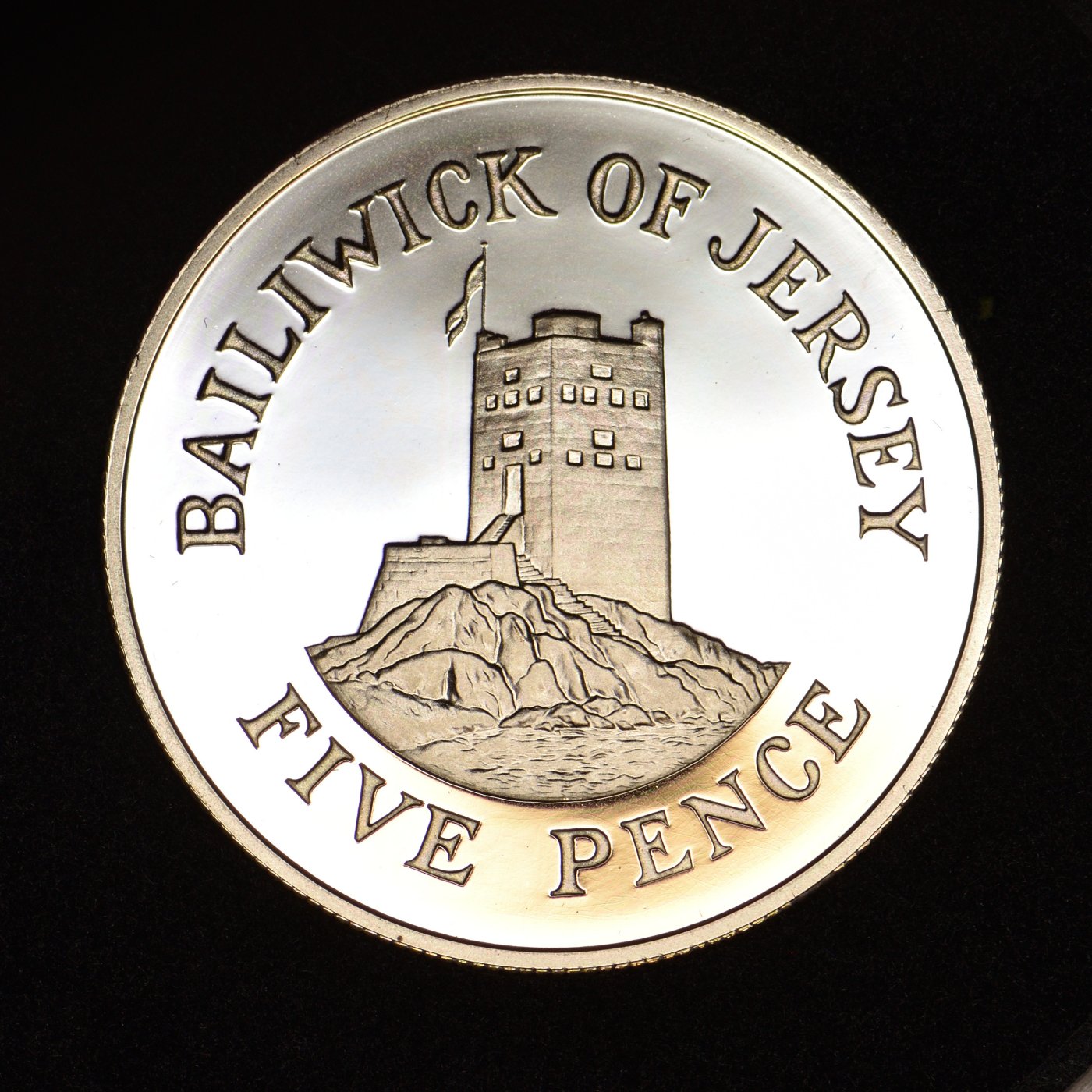 |
|
YEAR KM mintage diameter
1983 56.1 400,000 23.59
1984 300,000
1985 600,000
1986 200,000
1987 10,000
1988 400,000
1990 56.2 4,000,000 18.00
1991 2,000,000
1992 1,000,000
1993 2,000,000
1997 5,500
1998 105 3,200,000
2002 1,218,000
2003 1,005,000
2006 1,200,000
2008 5,400,000
2012 1,622,000
2014 862,000
2016 1,320,000
The first tower erected here was in 1540. The present tower, the only square tower in Jersey, was built in 1782. It is positioned
on a rock 1 1⁄4 miles out in the Royal Bay of Grouville.
Things to note about this series:
- The reverse design is by Robert Lowe.
- The Royal Mint document MINT-35-CRQ-Z.pdf discusses the new coinage designs.
- The 1987 coins were available only in mint sets. The coins have a bright relief and were struck from burnished blanks.
See the Royal Mint document MINT-35-CR2-Z.pdf concerning this issue.
- The Royal Mint document MINT-35-CRM-Z.pdf concerns the 1983 and 1984 mintage.
- The Royal Mint document MINT-35-CRN-Z.pdf concerns the 1985, 1986, and 1987 mintages.
- The Royal Mint document MINT-36-CGP-Z.pdf concerns the 1988 mintage.
- A total of 5005 1983 silver proof sets were also minted. Later in 1990, 3986 sets were melted for silver.
Thus the total mintage of the 1983 silver proof set is 1019.
See the Royal Mint documents
MINT-35-CRR-Z.pdf
and MINT-36-CGP-Z.pdf for details.
- These larger diameter coin ceased to be legal tender after December 31, 1990.
- In February of 1991, 349 boxes of unsorted 5p coins and 16 boxes of Jersey 5p coins were return to the Royal Mint
for scrap. It is estimated that 1,000,000 Jersey 5p coins were scrapped. See
MINT-36-CGP-Z.pdf for details.
- The 1997 coins were available only in mint sets.
- The Royal Mint document MINT-36-CGP-Z.pdf concerns the 1990 mintage.
- The Royal Mint document MINT-36-CGN-Z.pdf mentions the 1991 mintage.
- The Royal Mint document MINT-36-CG4-Z.pdf concerns the 1992 mint set.
- The 1998 dated coins had 1,200,000 struck in 2000. See the Royal Mint document MINT-43-7-Z.pdf for details.
- The 2008 dated coins were minted in the following years: 2008 and 2009.
- The 2012 dated coins were minted in the following years: 2012, 2013, 2014, and 2015.
- The 2014 dated coins were minted in the following years: 2015 and 2016.
- The 2016 dated coins were minted in the following years: 2016 and 2017.
- For recent mintage information see The States of Jersey documents "Coin in circulation from year 2000"
and "Coins minted from 2013 to March 2018 Summary".
| 1983 Five Pence Statistics |
| Work Order |
Date |
Quantity |
| 20 |
February 10, 1983 |
200,000 |
| 105 |
October 5, 1983 |
200,000 |
|
| 1988 Five Pence Statistics |
| Work Order |
Date |
Quantity |
| 866 |
August 3, 1988 |
200,000 |
| 42 |
June 27, 1989 |
200,000 |
|
| 2008 Five Pence Statistics |
| Date |
Quantity |
| 2008 |
3,600,000 |
| 2009 |
1,800,000 |
|
| 1984 Five Pence Statistics |
| Work Order |
Date |
Quantity |
| 131 |
December 7, 1983 |
200,000 |
| 215 |
September 18, 1984 |
100,000 |
|
| 1990 Five Pence Statistics |
| Work Order |
Date |
Quantity |
| 139 |
January, 1990 |
1,000,000 |
| 256 |
August 2, 1990 |
1,000,000 |
| 286 |
October 8, 1990 |
1,000,000 |
| 328 |
January 14, 1991 |
1,000,000 |
|
| 2012 Five Pence Statistics |
| Date |
Quantity |
| 2012 |
480,000 |
| 2013 |
480,000 |
| 2014 |
74,000 |
| 2015 |
588,000 |
|
| 1985 Five Pence Statistics |
| Work Order |
Date |
Quantity |
| 278 |
February 18, 1985 |
300,000 |
| 367 |
September 10, 1985 |
300,000 |
|
| 1991 Five Pence Statistics |
| Work Order |
Date |
Quantity |
| 408 |
- |
2,000,000 |
|
| 2014 Five Pence Statistics |
| Date |
Quantity |
| 2015 |
142,000 |
| 2016 |
720,000 |
|
| 1986 Five Pence Statistics |
| Work Order |
Date |
Quantity |
| 456 |
February 25, 1986 |
200,000 |
|
| 1998 Five Pence Statistics |
| Work Order |
Date |
Quantity |
| 35 |
September 28, 1999 |
2,000,000 |
| 434 |
November 7, 2000 |
1,200,000 |
|
| 2016 Five Pence Statistics |
| Date |
Quantity |
| 2016 |
360,000 |
| 2017 |
480,000 |
| Jan to Mar 2018 |
480,000 |
|
Ten New Pence
(click on image to enlarge) |
|---|
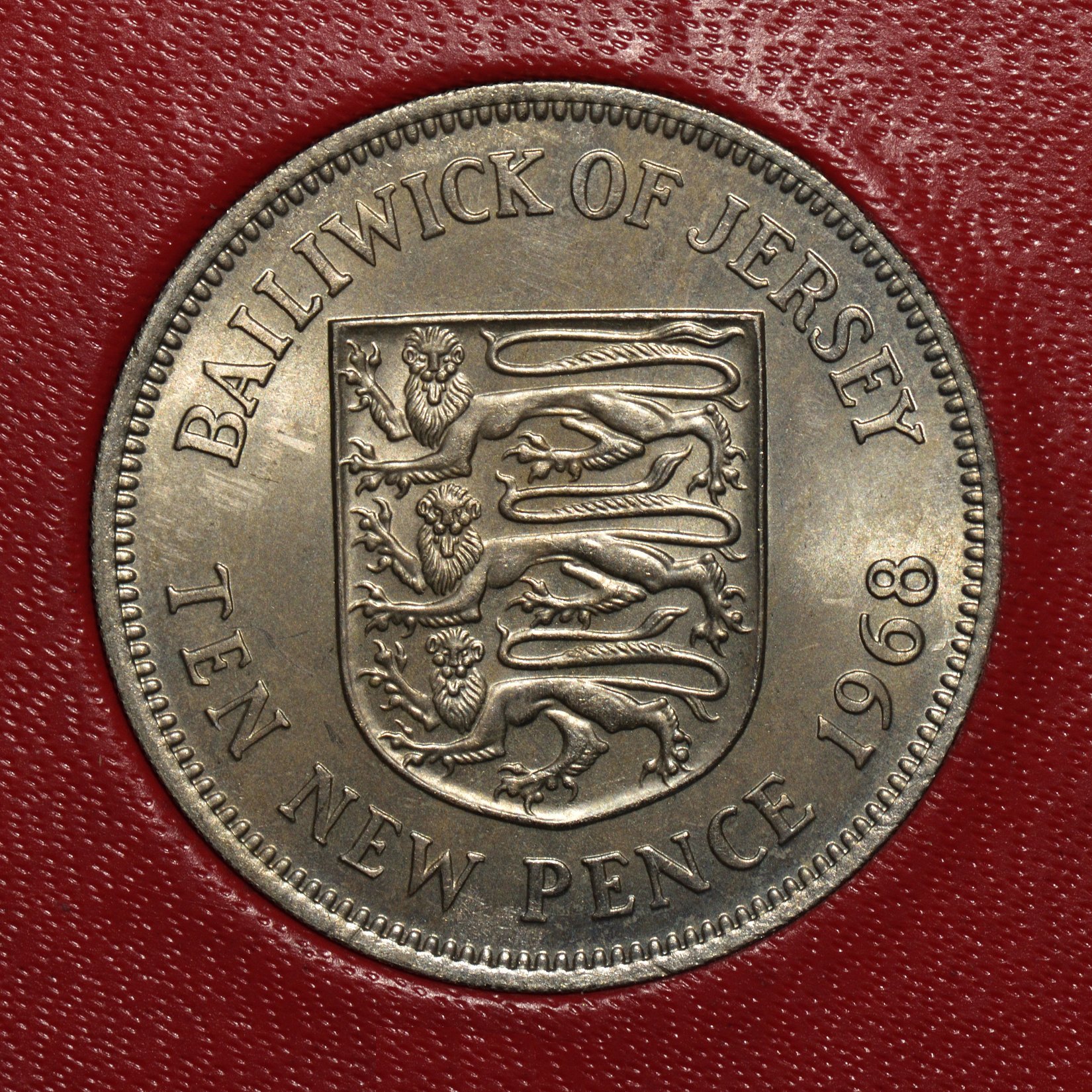 |
YEAR KM mintage diameter
1968 33 1,500,000 28.50
1975 1,022,000
1980 1,000,000
Things to note about this series:
- The total mintage for 1975 is 1,022,000 pieces. 300,000 coins were minted in 1975.1
An additional 722,000 coins were minted via
Work Order No. 467 dated May 18, 1979.
- An additional 7,800 coins were minted as a part of a 1980 proof set, which was struck by Birmingham Mint Pressings Limited.
See the Royal Mint document MINT-34-T5-Z.pdf for details.
- For the 1980 coins, see the Royal Mint documents MINT-34-T3-Z.pdf and
MINT-34-TX-Z.pdf for information concerning the mintage figures and designs.
- See the Royal Mint document MINT-33-PG-Z.pdf for information concerning the delivery of coins.
| 1968 Ten New Pence Statistics |
| Date |
Quantity |
| 1969 |
1,000,000 |
| 1970 |
500,000 |
|
| 1975 Ten New Pence Statistics |
| Date |
Quantity |
| 1975 |
300,000 |
| 1979 |
722,000 |
|
| 1980 Ten New Pence Statistics |
| Work Order |
Date |
Quantity |
| 562 |
February 19, 1980 |
1,000,000 |
|
Ten Pence
(click on image to enlarge) |
|---|
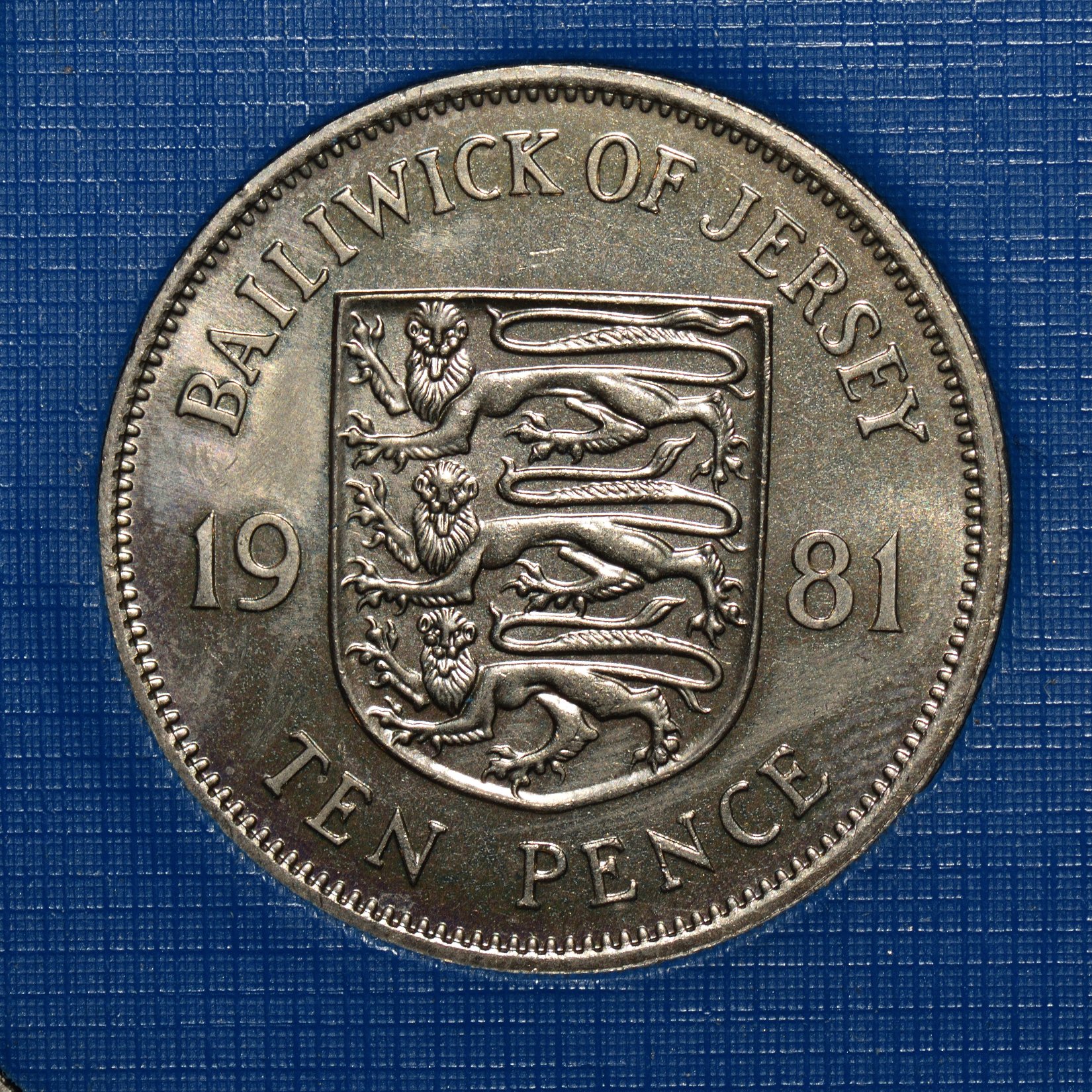 |
YEAR KM mintage diameter
1981 49 50,000 28.50
Things to note about this series:
- An additional 6,000 coins were minted as a part of a 1981 proof set, which was struck by Birmingham Mint Pressings Limited.
See the Royal Mint document MINT-34-T5-Z.pdf for details.
- See the Royal Mint document MINT-34-T3-Z.pdf
for information concerning the mintage figures and designs.
| 1981 Ten Pence Statistics |
| Work Order |
Date |
Quantity |
| 723 |
March 27, 1981 |
50,000 |
Ten Pence
Faldouet Dolmen
(click on image to enlarge) |
|---|
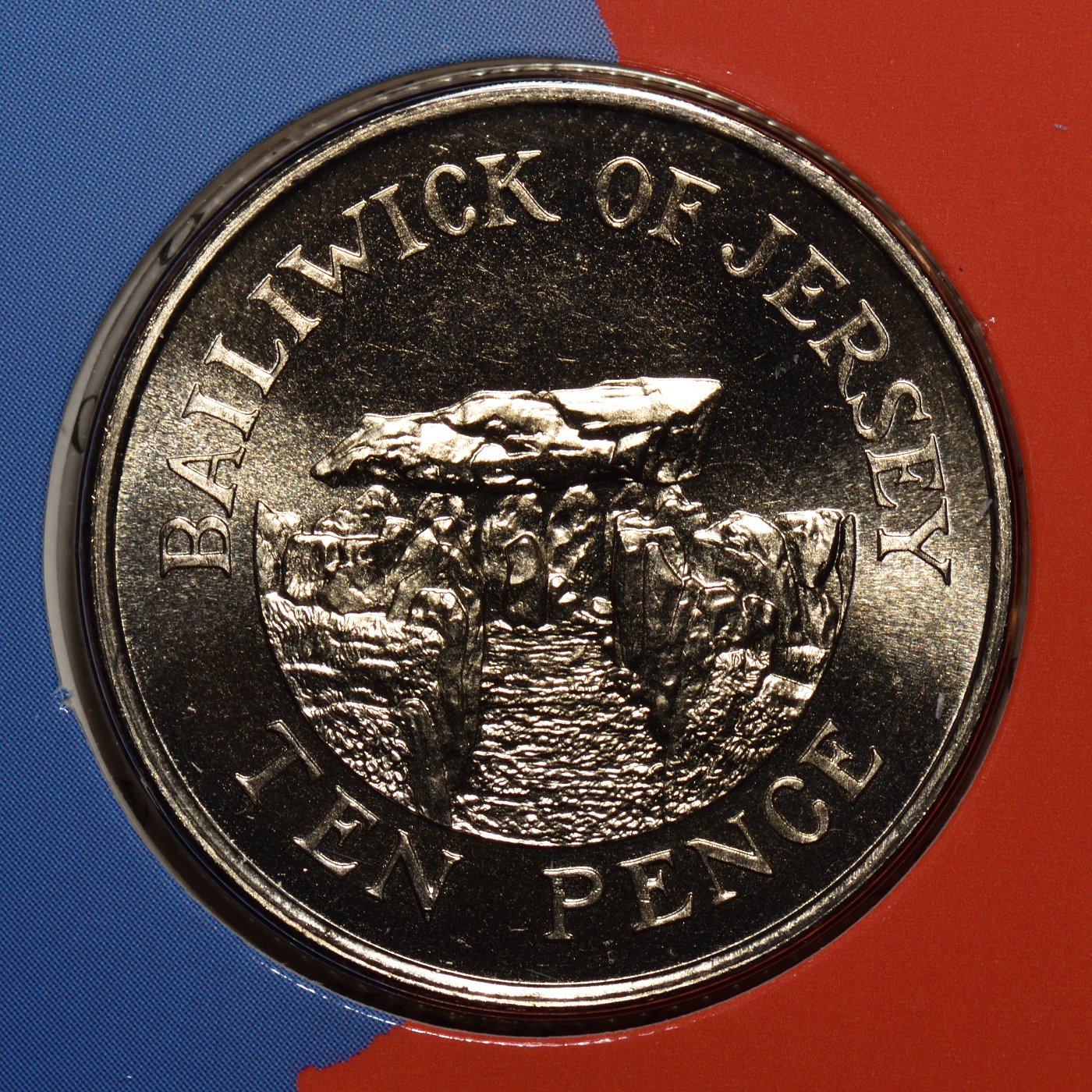 |
|
Silver Proof Ten Pence
Faldouet Dolmen
(click on image to enlarge) |
|---|
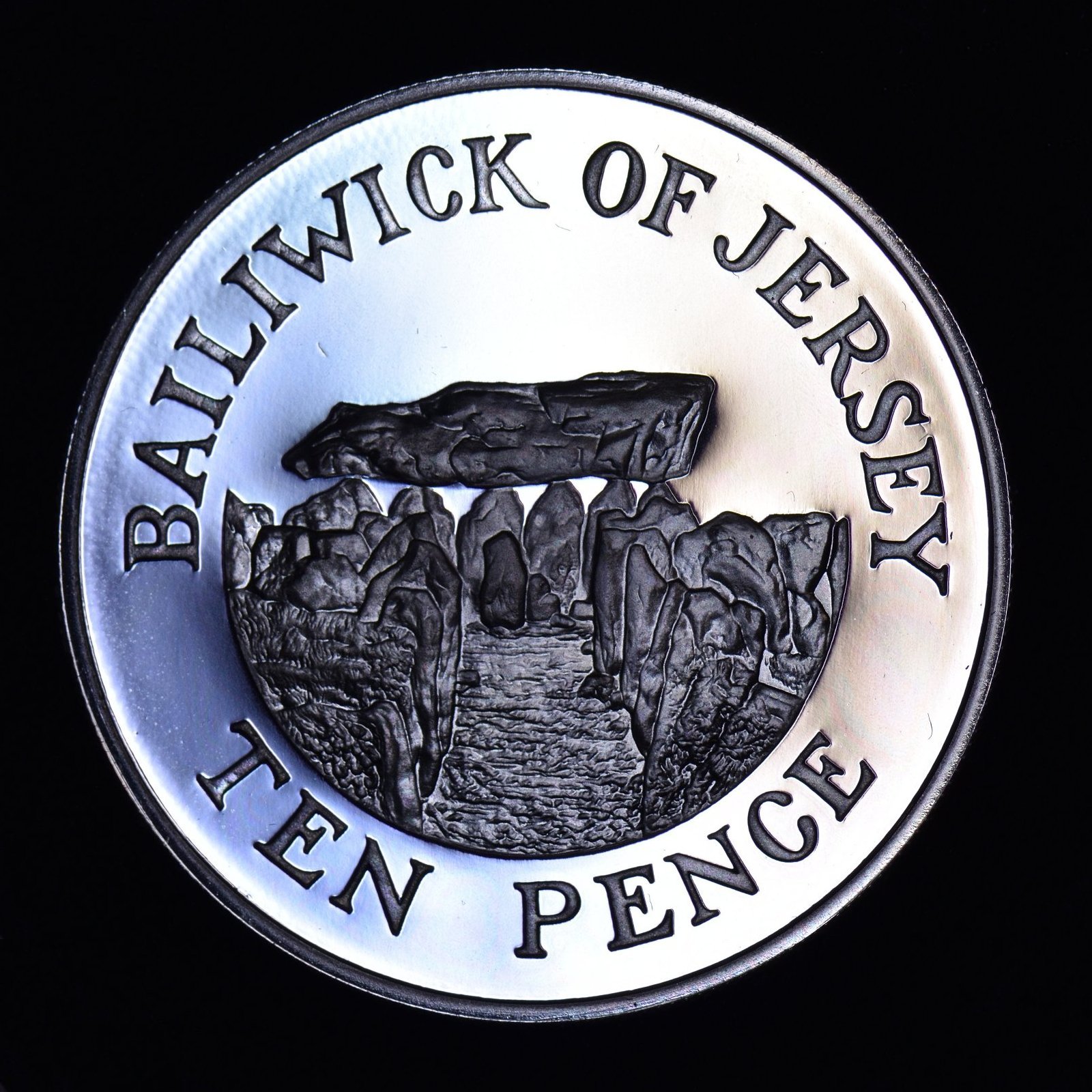 |
|
YEAR KM mintage diameter
1983 57.1 30,000 28.50
1984 100,000
1985 100,000
1986 400,000
1987 800,000
1988 650,000
1989 700,000
1990 850,000
1992 57.2 7,000,000 24.50
1997 5,500
2002 106 516,000
2003 10,000
2006 420,000
2007 630,000
2010 640,000
2012 580,000
2014 420,000
2016 490,000
Faldouet dolmen or La Pouquelaye de Faldouet dates back to about 2500BC.
It is a Neolithic dolmen and has been so changed by would-be archaeological
diggers and restorers over the centuries, which it is impossible to say for sure how it looked originally.
A passage of 17 stones leads to a roughly circular chamber
surrounded by the remains of side-cells and beyond that is a horseshoe chamber of seven uprights covered by a
huge capstone weighing about 24 tons.
The term 'Pouquelaye' needs explaining. Pouquelaye or pouclee means fairystone.
Long after the menhir and dolmens on the island had ceased to be the ritual
centers for prehistoric man, many of the stones were still venerated for their huge size and continued to
have a role to play in the supernatural beliefs of the
islanders.
As the original purpose of these stones had long been forgotten, their presence was explained by later generations
as a result of fairy magic.
The stones were thought to have been borne through the air by fairies - carried in their magic aprons!
Things to note about this series:
- The reverse design is by Robert Lowe.
- The larger diameter coin ceased to be legal tender after June 30, 1993.
- The Royal Mint document MINT-35-CRQ-Z.pdf discusses the new coinage designs.
- The Royal Mint document MINT-35-CRM-Z.pdf
concerns the 1983 and 1984 mintage.
- The Royal Mint document MINT-35-CRN-Z.pdf concerns the 1985, 1986, and 1987 mintages.
- The Royal Mint document MINT-35-CR2-Z.pdf concerns the 1987 mint set.
- The Royal Mint document MINT-36-CGP-Z.pdf concerns the
1988, 1989 and 1990 mintages.
- The smaller diameter coin was introduced on September 1, 1992.
- The Royal Mint document MINT-36-CG4-Z.pdf concerns the 1992 mint set.
- A total of 5005 1983 silver proof sets were also minted. Later in 1990, 3986 sets were melted for silver.
Thus the total mintage of the 1983 silver proof set is 1019.
See the Royal Mint documents MINT-35-CRR-Z.pdf
and MINT-36-CGP-Z.pdf for details.
- The 2012 dated coins were minted in the following years: 2012, 2014, and 2016.
- The 2016 dated coins were minted in the following years: 2016 and 2017.
- For recent mintage information see The States of Jersey documents "Coin in circulation from year 2000"
and "Coins minted from 2013 to March 2018 Summary".
| 1983 Ten Pence Statistics |
| Work Order |
Date |
Quantity |
| 20 |
February 10, 1983 |
30,000 |
|
| 1987 Ten Pence Statistics |
| Work Order |
Date |
Quantity |
| 587 |
January 28, 1987 |
600,000 |
| 686 |
August 25, 1987 |
200,000 |
|
| 2012 Ten Pence Statistics |
| Date |
Quantity |
| 2012 |
160,000 |
| 2014 |
210,000 |
| 2015 |
210,000 |
|
| 1984 Ten Pence Statistics |
| Work Order |
Date |
Quantity |
| 131 |
December 7, 1983 |
100,000 |
|
| 1988 Ten Pence Statistics |
| Work Order |
Date |
Quantity |
| 866 |
August 3, 1988 |
650,000 |
|
| 1985 Ten Pence Statistics |
| Work Order |
Date |
Quantity |
| 278 |
February 18, 1985 |
100,000 |
|
| 1989 Ten Pence Statistics |
| Work Order |
Date |
Quantity |
| 955 |
January 20, 1989 |
700,000 |
|
| 2016 Ten Pence Statistics |
| Date |
Quantity |
| 2016 |
210,000 |
| 2017 |
280,000 |
|
| 1986 Ten Pence Statistics |
| Work Order |
Date |
Quantity |
| 504 |
July 1, 1986 |
200,000 |
| 526 |
September 8, 1986 |
200,000 |
|
| 1990 Ten Pence Statistics |
| Work Order |
Date |
Quantity |
| 139 |
January, 1990 |
600,000 |
| 286 |
October 8, 1990 |
250,000 |
|
Twenty Pence
100th Anniversary of Lighthouse at Corbiere
(click on image to enlarge) |
|---|
 |
YEAR KM mintage diameter
1982 53 600,000 21.40
| Some Initial Designs |
|---|
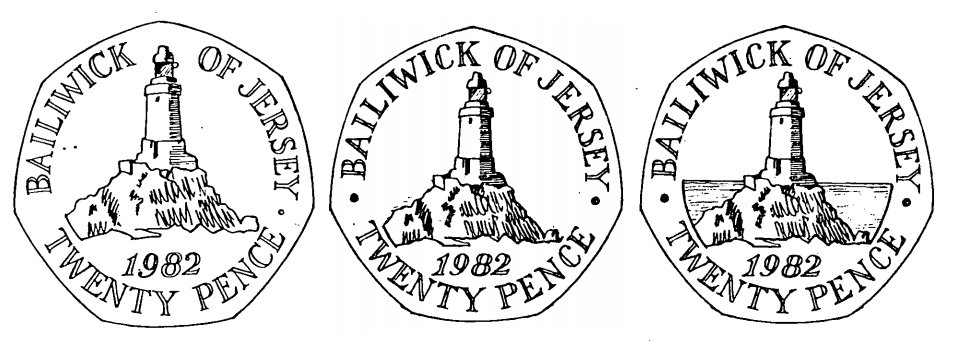 |
At the far southwest tip of Jersey is
Corbiere Lighthouse,
which was the first concrete lighthouse to be built in the British Isles, and warns
approaching ships of the dangerous rocks in the area. It was designed by Sir John Coode and was completed in 1873.
Things to note about this series:
- The reverse design is by Robert Lowe.
- An additional 1500 piedforte coins were made from burnished blanks supplied by the Birmingham Mint. It was arranged for 65 pieces to be
manufactured from buffed blanks to replace coins that were rejected due to customers complaints.
- See the Royal Mint documents MINT-35-CRP-Z.pdf and
MINT-35-CRH-Z.pdf
for information concerning the mintage figures and designs.
- The total mintage is 600,000 pieces, which is computed from:
| 1982 20 Pence Mintage Statistics |
| Work Order |
Date |
Quantity |
| 892 |
March 31, 1982 |
200,000 |
| 923 |
July 16, 1982 |
100,000 |
| 929 |
August 11, 1982 |
100,000 |
| 949 |
October 7, 1982 |
200,000 |
Twenty Pence
Lighthouse at Corbiere
(click on image to enlarge) |
|---|
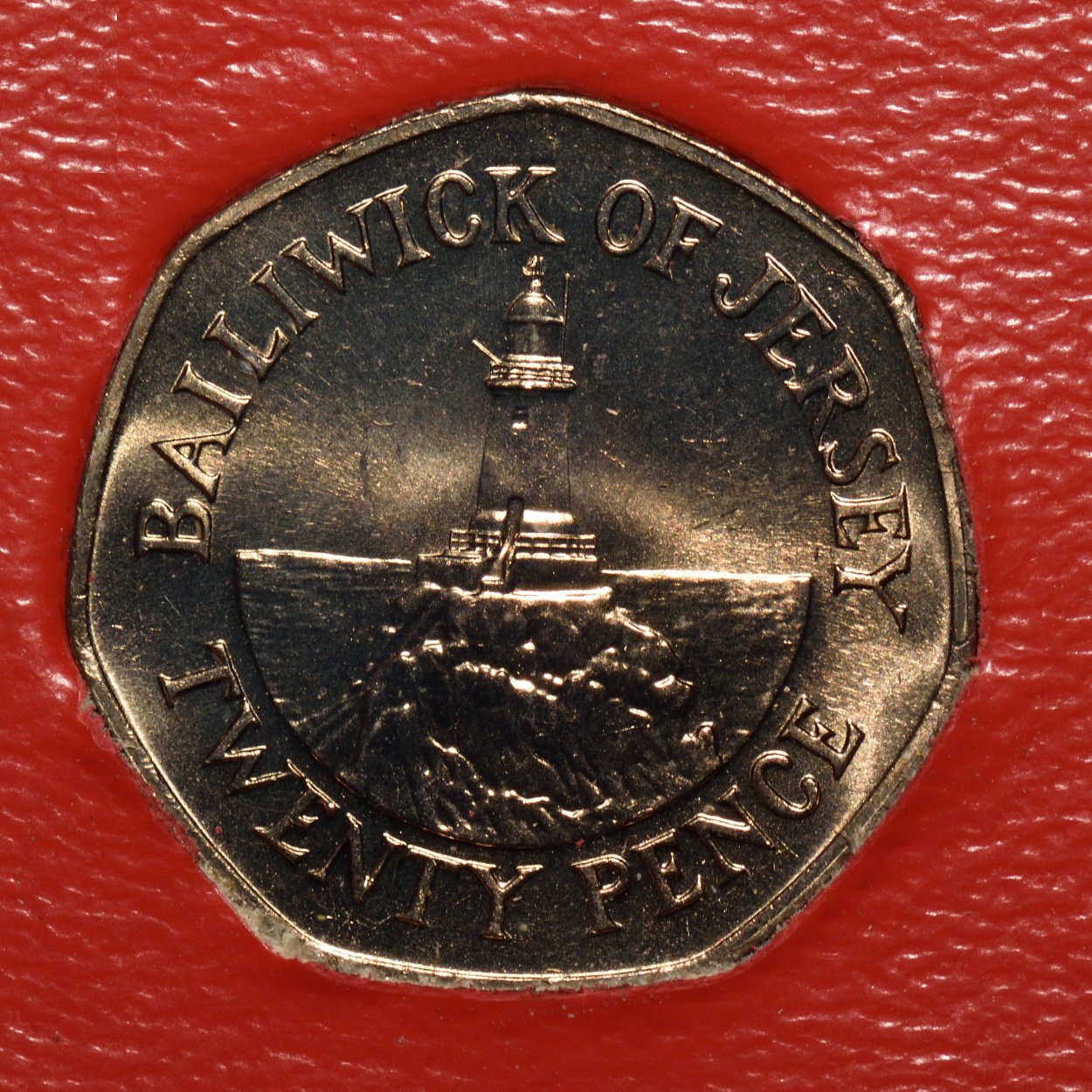 |
|
Silver Proof Twenty Pence
Lighthouse at Corbiere
(click on image to enlarge) |
|---|
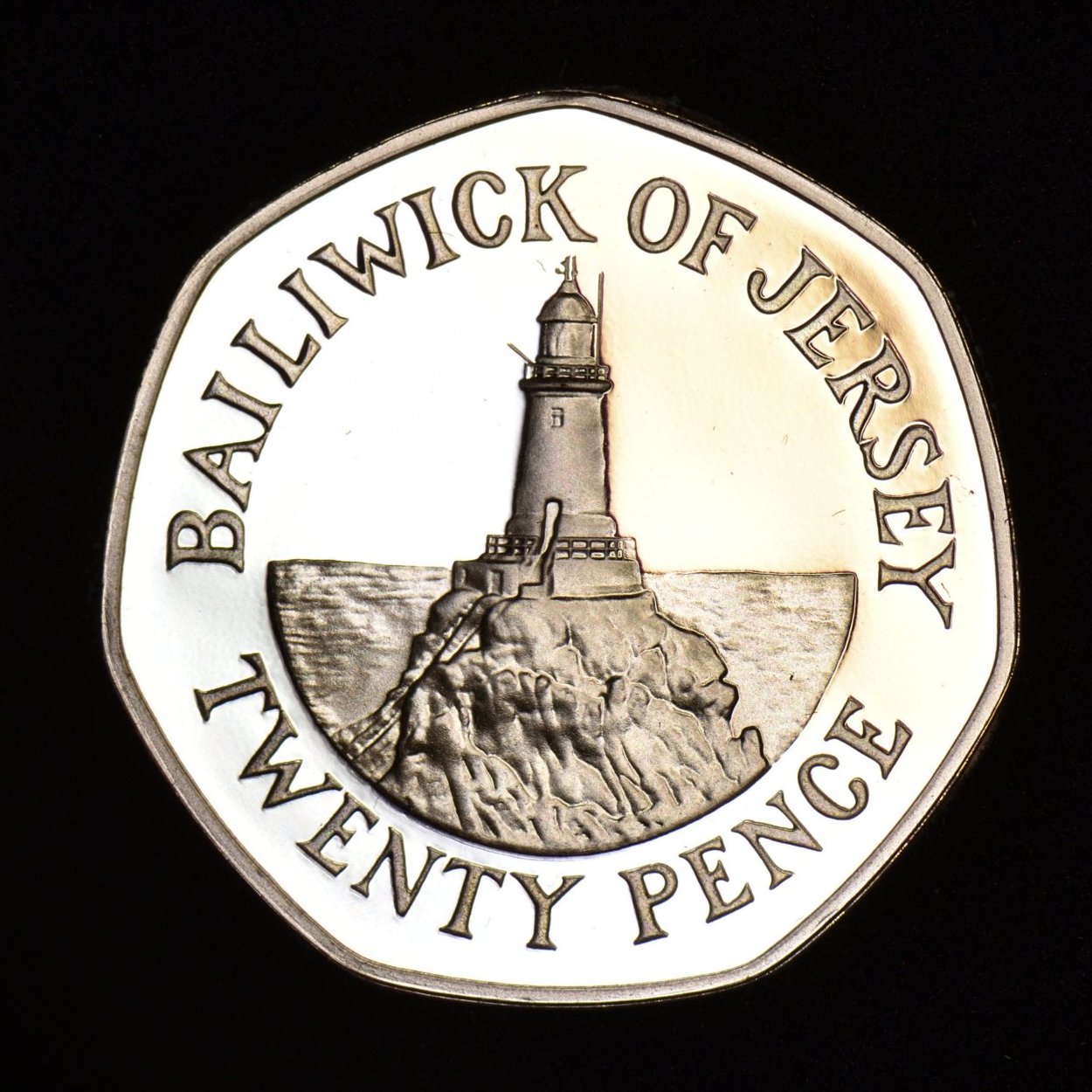 |
|
YEAR KM mintage diameter
1983 66 400,000 21.40
1984 250,000
1986 100,000
1987 100,000
1989 100,000
1990 150,000
1992 6,000
1994 200,000
1996 250,000
1997 600,000
1998 107 1,350,000
2002 977,500
2003 10,000
2005 500,000
2006 500,000
2007 780,000
2009 1,500,000
2012 1,298,750
2014 600,000
2016 1,450,000
Things to note about this series:
- The Royal Mint document MINT-35-CRM-Z.pdf concerns the 1983 and 1984 mintage.
- A total of 5005 1983 silver proof sets were also minted. Later in 1990, 3986 sets were melted for silver.
Thus the total mintage of the 1983 silver proof set is 1019.
See the Royal Mint documents
MINT-35-CRR-Z.pdf
and MINT-36-CGP-Z.pdf for details.
- The Royal Mint document MINT-35-CRN-Z.pdf concerns the 1986
and 1987 mintages.
- The Royal Mint document MINT-35-CR2-Z.pdf concerns the 1987 mint set.
- The Royal Mint document MINT-36-CGP-Z.pdf concerns the 1988, 1989 and 1990 mintages.
- The 1992 coins were available only in mint sets. The Royal Mint document MINT-36-CG4-Z.pdf concerns the 1992 mint set.
- The 1998 dated coins had an additional 450,000 struck in 2001. See the Royal Mint document MINT-43-7-Z.pdf for details.
- The 2002 dated coins were minted in 2002 and 2003.
- The 2012 dated coins were minted in 2011, 2013, and 2014.
- The 2016 dated coins were minted in 2016 and 2017.
- For recent mintage information see The States of Jersey documents
"Coin in circulation from year 2000"
and "Coins minted from 2013 to March 2018 Summary".
|
| 1983 Twenty Pence Statistics |
| Work Order |
Date |
Quantity |
| 20 |
February 10, 1983 |
400,000 |
|
| 1987 Twenty Pence Statistics |
| Work Order |
Date |
Quantity |
| 587 |
January 28, 1987 |
100,000 |
|
| 2002 Twenty Pence Statistics |
| Date |
Quantity |
| 2002 |
462,500 |
| 2003 |
515,000 |
|
| 1984 Twenty Pence Statistics |
| Work Order |
Date |
Quantity |
| 131 |
December 7, 1983 |
250,000 |
|
| 1990 Twenty Pence Statistics |
| Work Order |
Date |
Quantity |
| 139 |
January, 1990 |
150,000 |
|
| 2012 Twenty Pence Statistics |
| Date |
Quantity |
| 2011 |
281,250 |
| 2013 |
337,500 |
| 2014 |
680,000 |
|
| 1986 Twenty Pence Statistics |
| Work Order |
Date |
Quantity |
| 456 |
February 25, 1986 |
50,000 |
| 526 |
September 8, 1986 |
50,000 |
|
| 1998 Twenty Pence Statistics |
| Work Order |
Date |
Quantity |
| 0 |
August, 8 1999 |
900,000 |
| 035 |
September, 25 2000 |
450,000 |
|
| 2016 Twenty Pence Statistics |
| Date |
Quantity |
| 2016 |
300,000 |
| 2017 |
670,000 |
| Jan to March 2018 |
480,000 |
|
Twenty Five Pence
Queen's Silver Jubilee
(click on image to enlarge) |
|---|
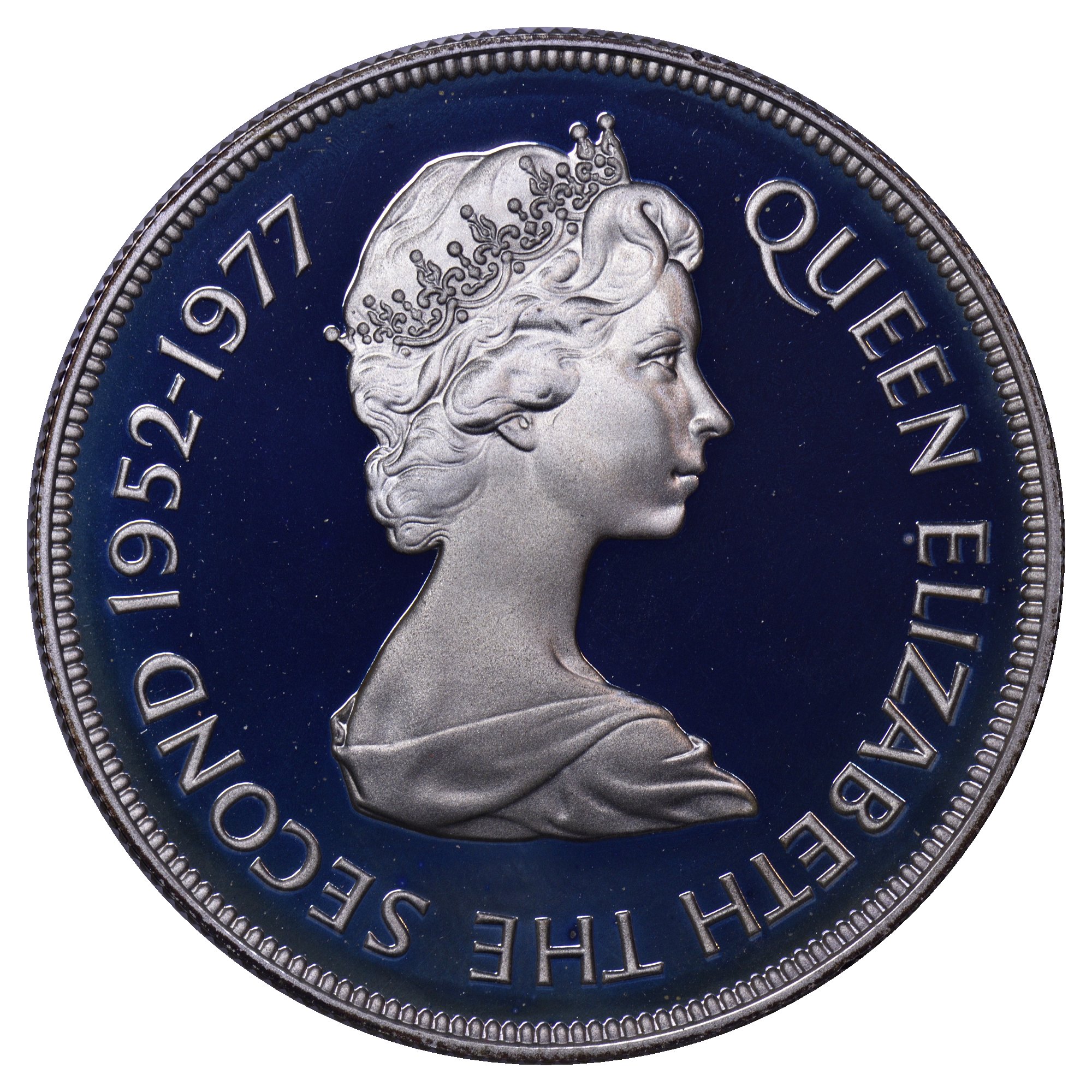 |
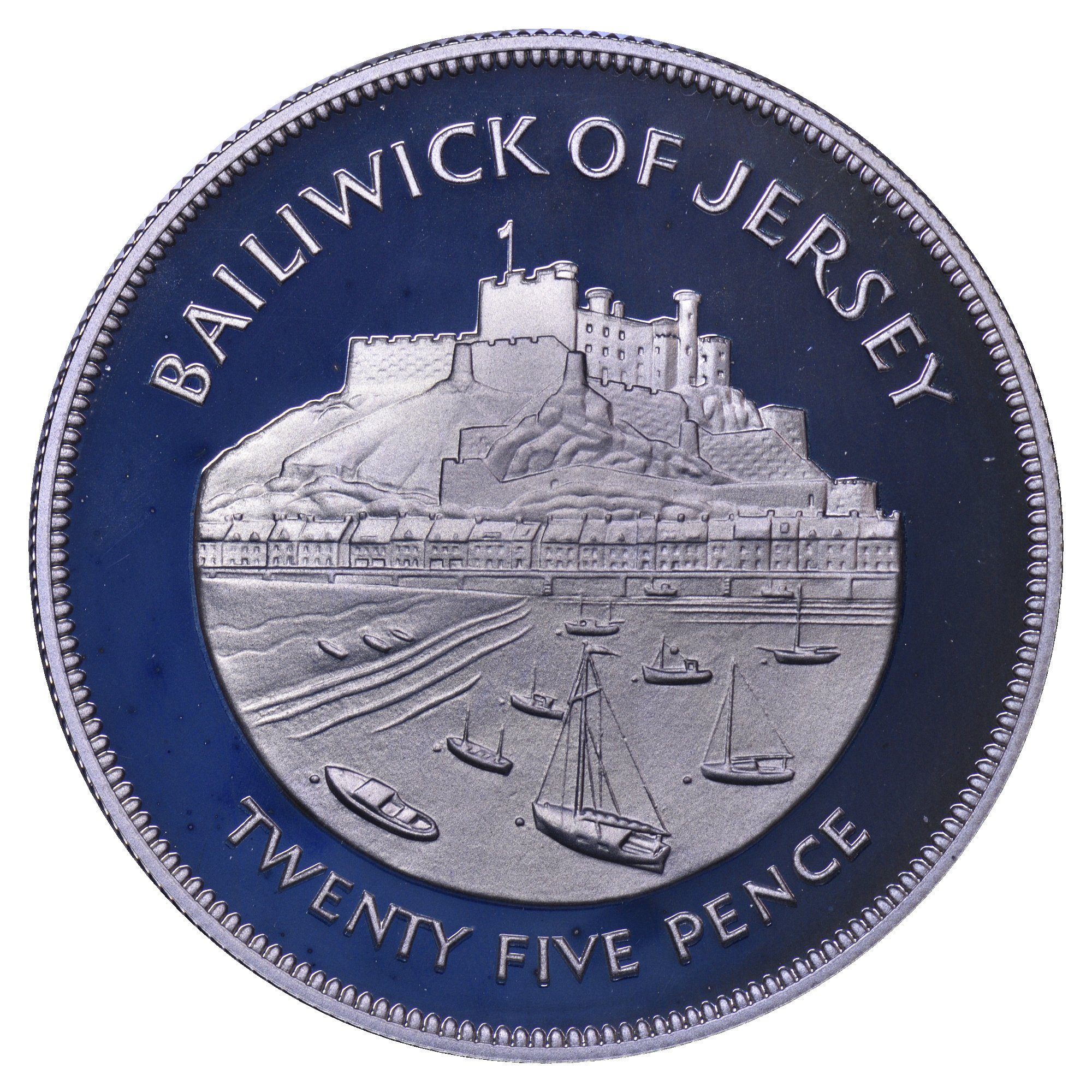 |
YEAR KM mintage diameter
1977 44 260,000 38.61
This is a circulating commemorative coin celebrating the Queen's Silver Jubilee of reign.
The obverse inscription and the reverse were designed and modelled by a team of artists consisting of William Gardner, Christopher Ironside, and Bernard Sindall.2
The reverse design is the royal and ancient castle of
Mont Orgueil, which stands above Gorey Harbour and was for centuries the
residence of the Lords, Keepers and Governors of Jersey. Its name, meaning Mount Pride, was given to it by Thomas,
Duke of Clarence, brother of Henry V, who was impressed by its unique position and great strength.
In 1966, Her Majesty Queen Elizabeth II, transferred ownership of Mont Orgueil Castle
(and Elizabeth Castle)
from the Crown to the people of Jersey on condition that the castles were to be maintained as historic monuments
although they had already been in the care of the Island since 1923. On 6th July 1996, the Lieutenant Governor -
The Queen's representative in the Island - presented the keys of both castles to the Bailiff. In accordance with
the specified condition, Mont Orgueil has since undergone extensive restoration work to help ensure its historic
past is not forgotten.
It is interesting to note that in July of 1976, William Gardner suggested to Royal Mint Advisory Committee
this coin should have a design of:
"heraldry of mace backed by arms combinded with foliage decoration from the staple products of potato and tomato. The wreath could
readily include the flowers of these plants."3 This design was later rejected by the committee in favor
of having Mont Orgueil.
Things to note about this series:
- A total of 35,000 silver proofs were struck. In 1980, 2,430 crowns were returned from Jersey to the Mint for destruction.
- See the Royal Mint document MINT-33-PJ-Z.pdf
for information concerning the design of this coin.
- See the Royal Mint document MINT-34-T4-Z.pdf
for information concerning the mintages for this coin.
|
| 1977 Twenty Five Pence Statistics |
| Work Order |
Date |
Quantity |
| 88 |
November 9, 1976 |
260,000 |
Fifty New Pence
(click on image to enlarge) |
|---|
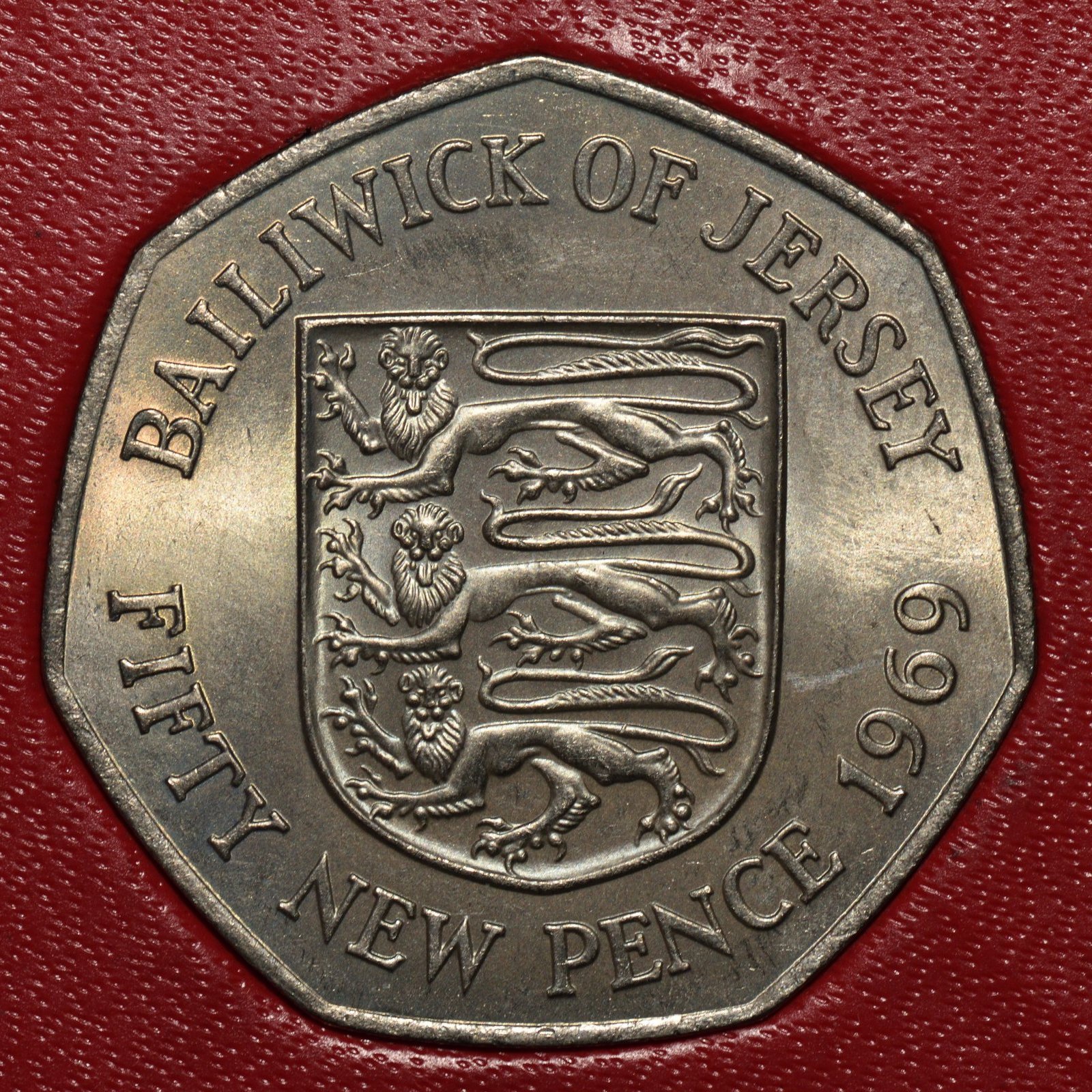 |
YEAR KM mintage diameter
1969 34 480,000 30.00
1980 100,000
Things to note about this series:
- This seven sided plain edge coin was released to circulation on October 14, 1969.
- The total mintage for 1969 is 480,000 pieces. Of these 80,000 coins were minted via
Work Order No. 467 dated May 18, 1979.
- An additional 7,800 coins were minted as a part of a 1980 proof set, which was struck by Birmingham Mint Pressings Limited.
See the Royal Mint document MINT-34-T5-Z.pdf for details.
- For the 1980 coins, see the Royal Mint documents MINT-34-T3-Z.pdf and
MINT-34-TX-Z.pdf for information concerning the mintage figures and designs.
| 1969 Fifty New Pence Statistics |
| Date |
Quantity |
| 1969 |
400,000 |
| 1979 |
80,000 |
|
| 1980 Fifty New Pence Statistics |
| Work Order |
Date |
Quantity |
| 562 |
February 19, 1980 |
100,000 |
|
Fifty Pence
(click on image to enlarge) |
|---|
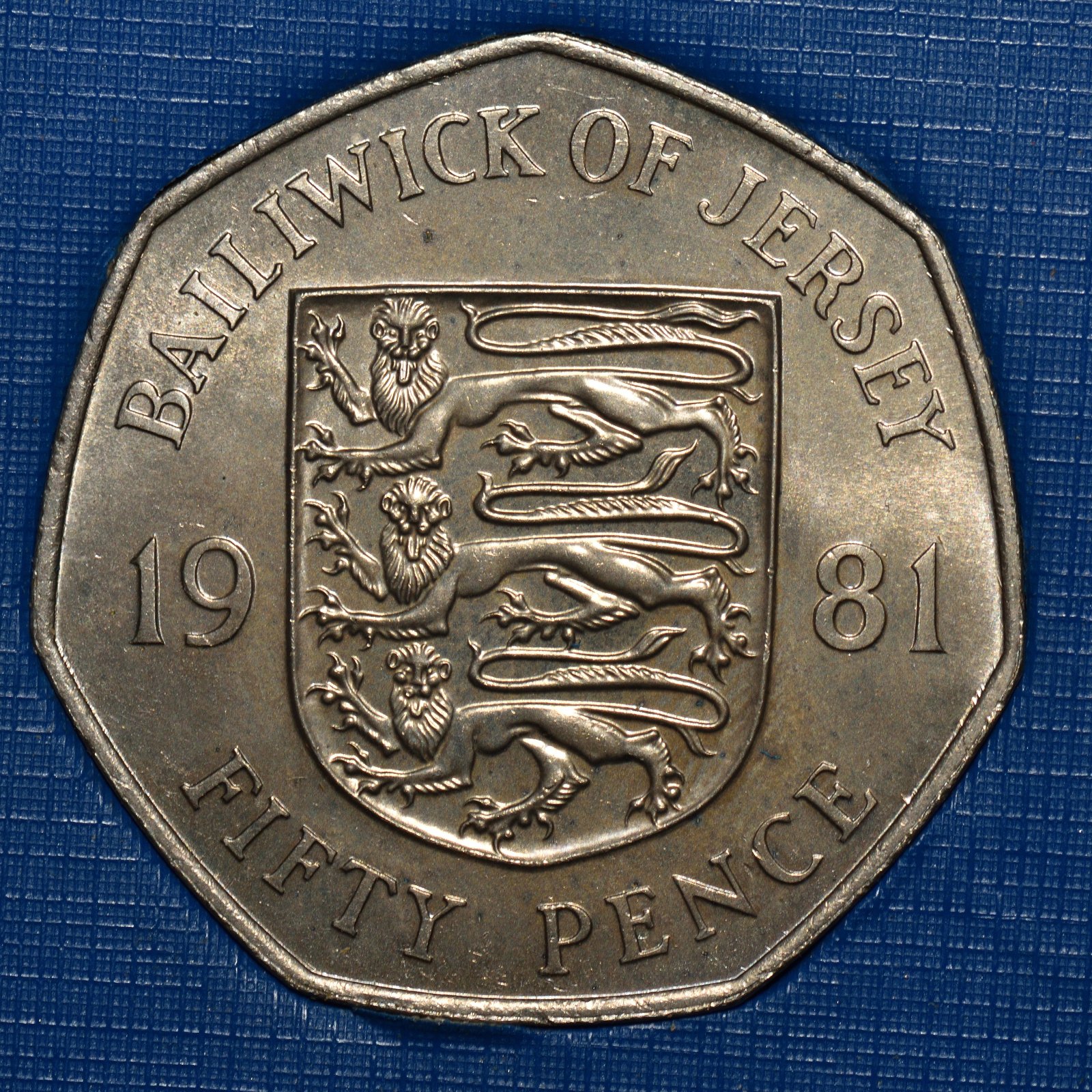 |
YEAR KM mintage diameter
1981 50 50,000 30.00
Things to note about this series:
- An additional 6,000 coins were minted as a part of a 1981 proof set, which was struck by Birmingham Mint Pressings Limited.
See the Royal Mint document MINT-34-T5-Z.pdf for details.
- See the Royal Mint document MINT-34-T3-Z.pdf for information about mintage figures and designs.
| 1981 Fifty Pence Statistics |
| Work Order |
Date |
Quantity |
| 723 |
March 27, 1981 |
50,000 |
Fifty Pence
Grosnez Castle
(click on image to enlarge) |
|---|
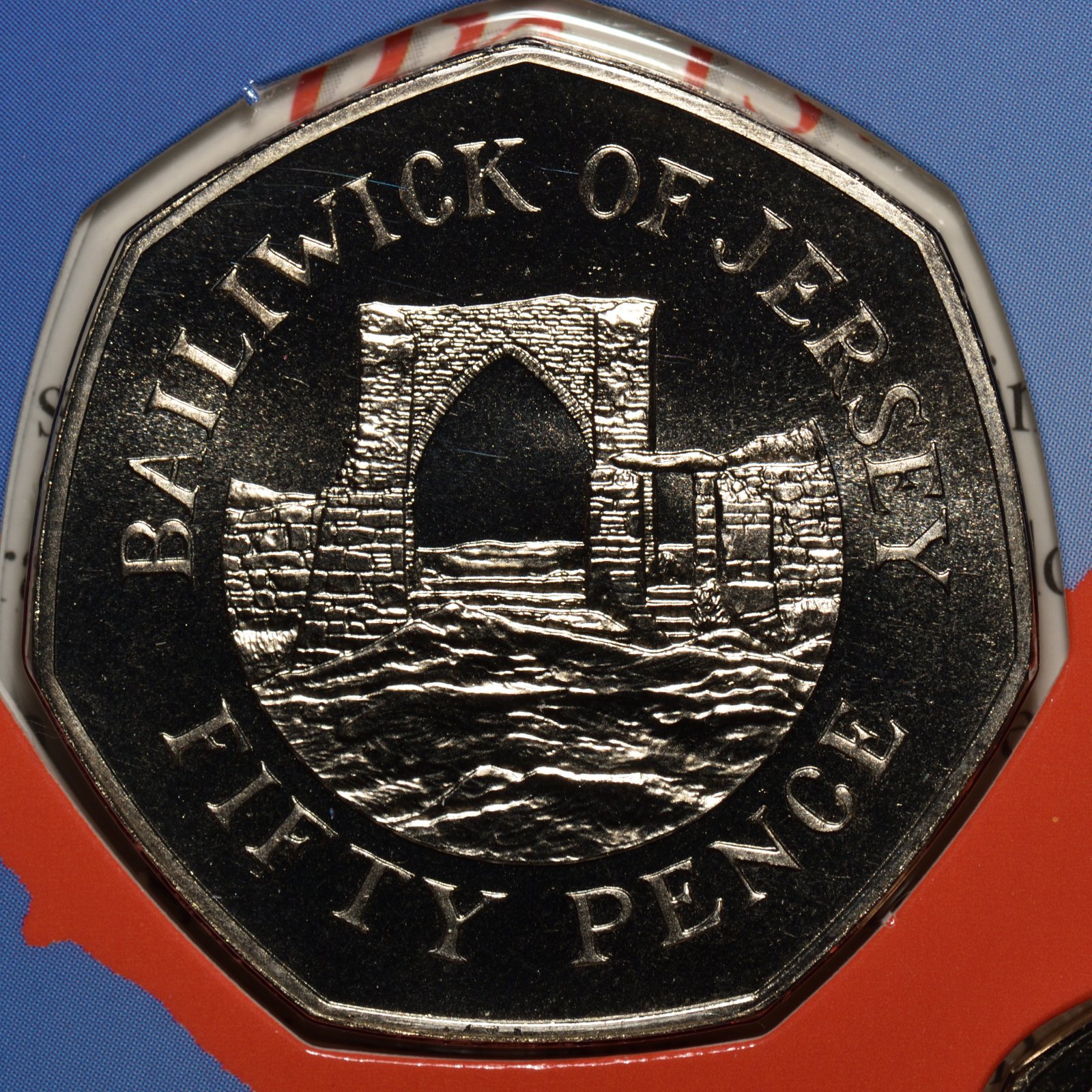 |
|
Silver Proof Fifty Pence
Grosnez Castle
(click on image to enlarge) |
|---|
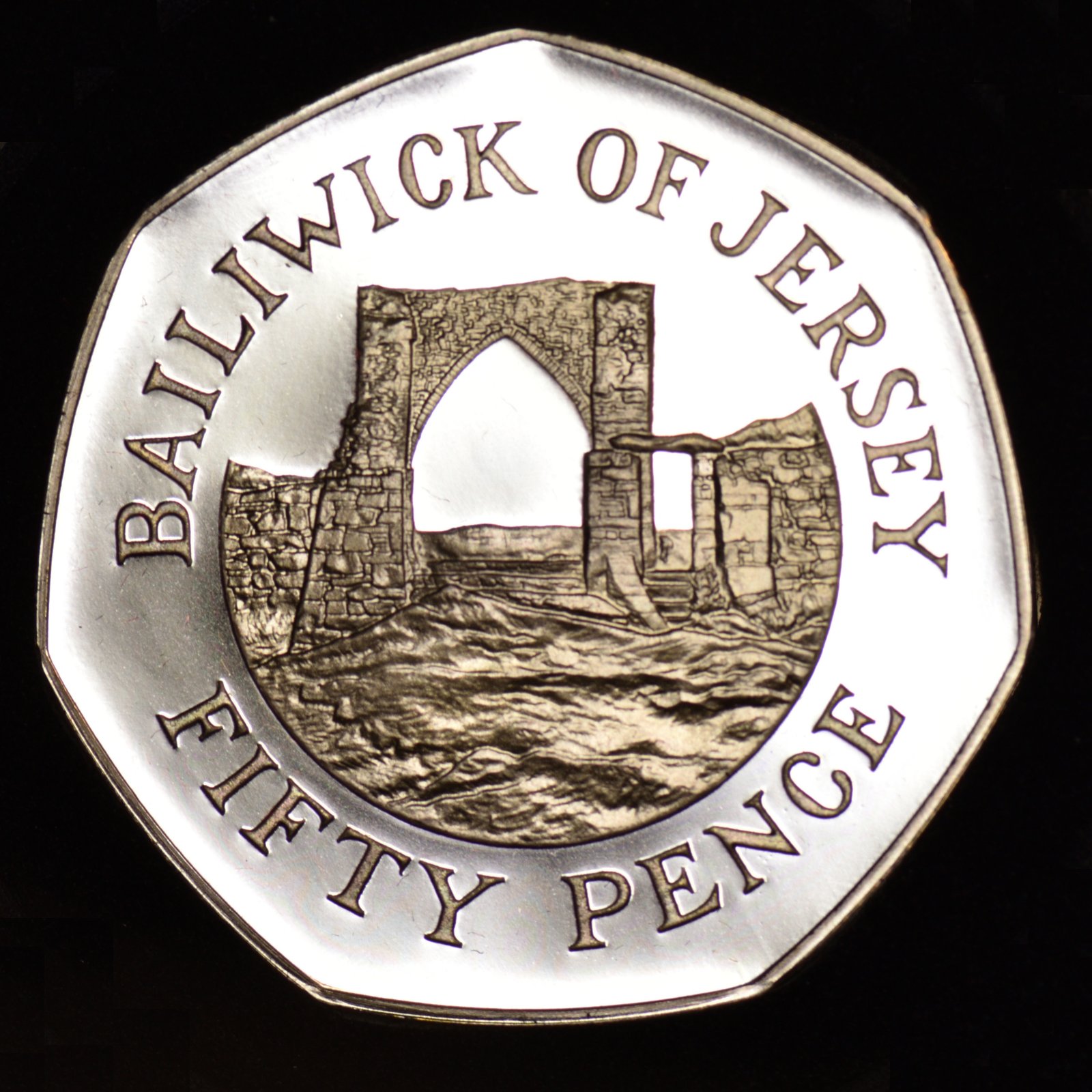 |
|
YEAR KM mintage diameter
1983 58.1 50,000 30.00
1984 50,000
1986 30,000
1987 150,000
1988 130,000
1989 180,000
1990 370,000
1992 6,000
1994 200,000
1997 5,500
1997 58.2 1,500,000 27.30
1998 108 2,000,000 27.30
2003 10,000
2005 200,000
2006 300,000
2009 480,000
2012 370,000
2014 240,000
2016 120,000
Grosnez Castle is a ruined 14th-century castle in Saint Ouen. The castle was built around 1330 to provide local farmers with a place of refugee from French attacks.
Depicted on the coin is the ruined gatehouse.
Things to note about this series:
- The reverse design is by Robert Lowe.
- The Royal Mint document MINT-35-CRQ-Z.pdf discusses the new coinage designs.
- The Royal Mint document MINT-35-CRM-Z.pdf concerns the 1983 and 1984 mintage.
- The Royal Mint document MINT-35-CRN-Z.pdf concerns the 1986 and 1987 mintages.
- The Royal Mint document MINT-35-CR2-Z.pdf concerns the 1987 mint set.
- The Royal Mint document MINT-36-CGP-Z.pdf concerns the 1988, 1989 and 1990 mintages.
- The 1992 coins were available only in mint sets. The Royal Mint document MINT-36-CG4-Z.pdf concerns this set.
- The 1997 coins were available only in mint sets.
- The larger diameter 50 pence coin ceased to be legal tender after
April 30, 1998.
- A total of 5005 1983 silver proof sets were also minted. Later in 1990, 3986 sets were melted for silver.
Thus the total mintage of the 1983 silver proof set is 1019.
See the Royal Mint documents
MINT-35-CRR-Z.pdf and MINT-36-CGP-Z.pdf for details.
- The Royal Mint document MINT-43-7-Z.pdf concerns the 1998 issue.
- The 2012 dated coins were minted in 2012, 2013, and 2014.
- For recent mintage information see The States of Jersey documents
"Coin in circulation from year 2000"
and
"Coins minted from 2013 to March 2018 Summary".
| 1983 Fifty Pence Statistics |
| Work Order |
Date |
Quantity |
| 20 |
February 10, 1983 |
50,000 |
|
| 1987 50 Pence Mintage Statistics |
| Work Order |
Date |
Quantity |
| 587 |
January 28, 1987 |
50,000 |
| 656 |
June 3, 1987 |
50,000 |
| 679 |
July 23, 1987 |
50,000 |
|
| 1990 Fifty Pence Statistics |
| Work Order |
Date |
Quantity |
| 139 |
January, 1990 |
120,000 |
| 286 |
October 8, 1990 |
250,000 |
|
| 1984 Fifty Pence Statistics |
| Work Order |
Date |
Quantity |
| 131 |
December 7, 1983 |
50,000 |
|
| 1988 Fifty Pence Statistics |
| Work Order |
Date |
Quantity |
| 752 |
January 19, 1988 |
130,000 |
|
| 1998 Fifty Pence Statistics |
| Work Order |
Date |
Quantity |
| 35 |
October 1999 |
500,000 |
|
| 1986 Fifty Pence Statistics |
| Work Order |
Date |
Quantity |
| 504 |
July 1, 1986 |
30,000 |
|
| 1989 Fifty Pence Statistics |
| Work Order |
Date |
Quantity |
| 955 |
January 20, 1989 |
60,000 |
| 69 |
August 31, 1989 |
120,000 |
|
| 2012 Fifty Pence Statistics |
| Date |
Quantity |
| 2012 |
10,000 |
| 2013 |
120,000 |
| 2014 |
240,000 |
|
Fifty Pence
40th Anniversary of Liberation
(click on image to enlarge) |
|---|
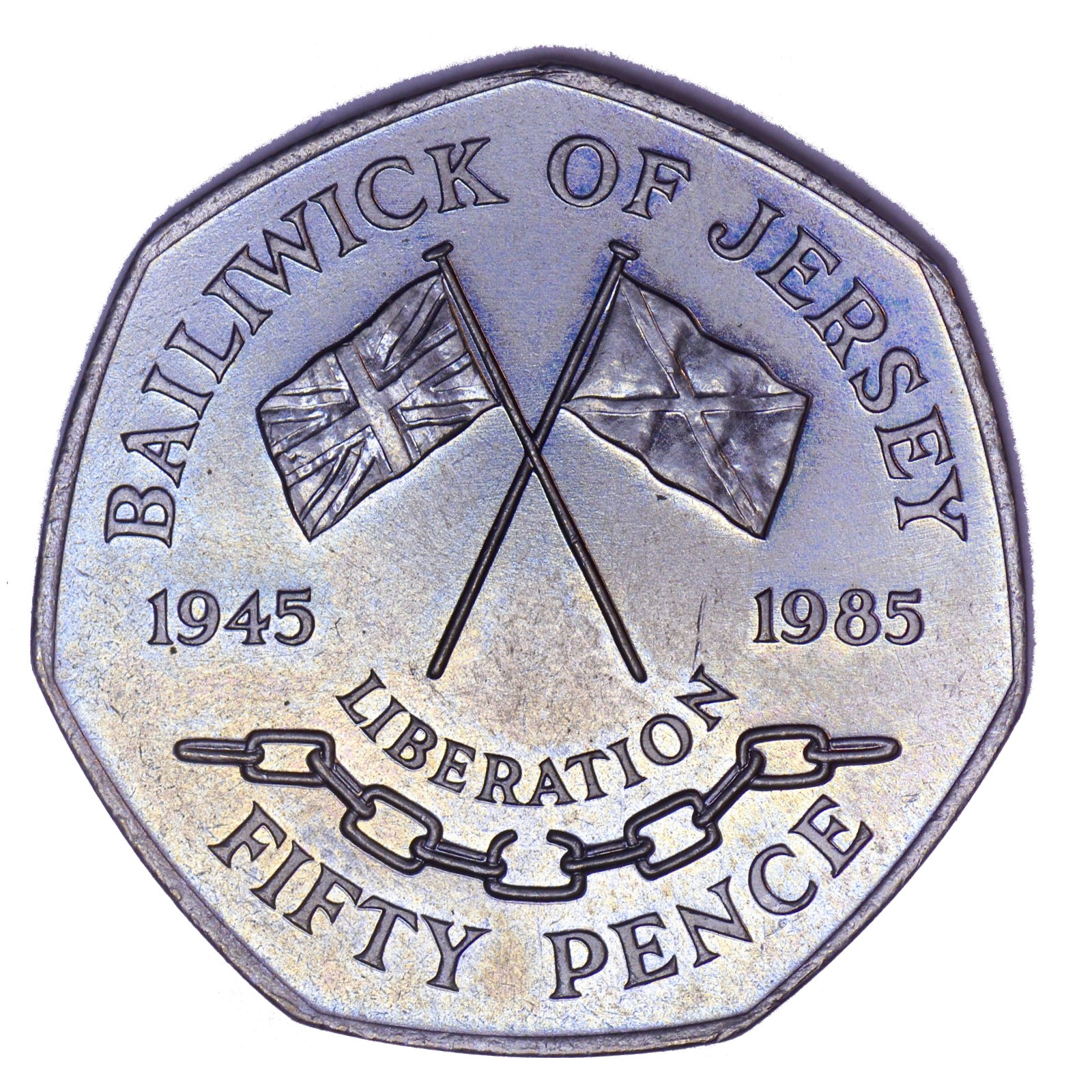 |
YEAR KM mintage diameter
1985 63 65,000 30.00
| Some Initial Designs |
A Letter by Ian Monins, States Coinage Advisor,
with Several Ideas |
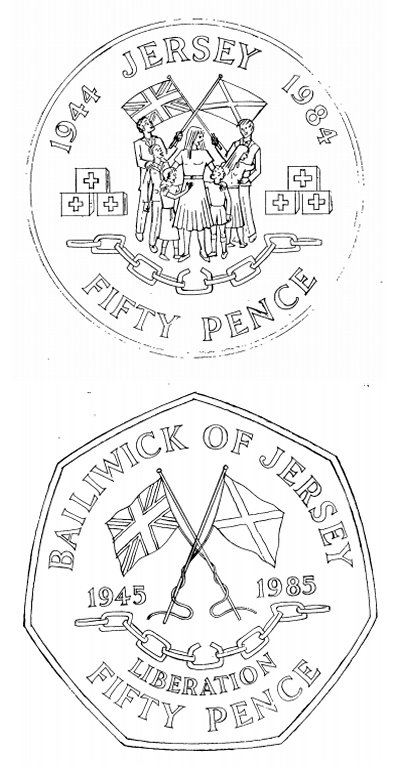 |
 |
Things to note about this series:
- The Royal Mint document MINT-35-CRV-Z.pdf concerns the design and the mintages.
- The coins for Work Order 356 were delivered to the Franklin Mint.
| 1985 50 Pence Mintage Statistics |
| Work Order |
Date |
Quantity |
| 356 |
August 23, 1985 |
15,000 |
| 270 |
February 11, 1986 |
50,000 |
| The Proposed 1977 Coins |
|---|
 |
|---|
Starting in May of 1977 Mr J Clennett, Treasurer for the States of Jersey, was in contact with the Royal Mint
to order coins without the word "NEW." In June sketches of all the denominations with two alternatives were submitted
to the States of Jersey Treasury. In each case, the design has the seal of the Bailiwick with "BAILIWICK OF JERSEY"
in its original position and with the value and date underneath the shield. The other design had the "BAILIWICK OF JERSEY"
more spaced out. The other difference was the first had dots before and after "BAILIWICK OF JERSEY." Jersey's Finance and
Economics Committee indicated that they would preferred having the date split left and right of the center shield
(similar to the 1877 1/12th of a shilling.) The modified design was approved and on July 27, 1977, a coinage order
was made. During November and December 1977 two sample coins (from 24 originally struck) of each denomination were
sent to the States Treasury for approval. Although they meet approval, a problem arose when it was discovered that
the law required amending to remove the word "NEW" on the coinage. A year and a half later, coins were still needed but no changes
to the law had been made, so in May of 1979, a work order was issued requesting coins made from previously dated dies.
Finally, in January 1980, the 1977 order was canceled. Eventually, coins without the word "NEW" were minted in 1981.
Of course, it does not answer the question, "Is the 1977 Twenty Five Pence commemorative issue a legitimate issue?"
See the Royal Mint document MINT-34-T3-Z.pdf
for more information concerning the 1977 coins.
Because of the difficulty about removing the word "NEW", the following coins were ordered using older dies.
| Coins Minted by Work Oder 467 dated May 18, 1979 |
| Denomination |
Date |
Quantity |
| 50P |
1969 |
80,000 |
| 10P |
1975 |
722,000 |
| 5P |
1969 |
600,000 |
| 2P |
1975 |
250,000 |
| 1P |
1971 |
500,000 |
| Check List |
| Half Penny |
Penny |
Two Pence |
Five Pence |
Ten Pence |
Twenty Pence |
Fifty Pence |
|
|
|
1968 |
1968 |
|
|
|
|
|
|
|
|
1969 |
| 1971 |
1971 |
1971 |
|
|
|
|
|
|
1975 |
|
1975 |
|
|
| 1980 |
1980 |
1980 |
1980 |
1980 |
|
1980 |
| 1981 |
1981 |
1981 |
1981 |
1981 |
|
1981 |
|
|
|
|
|
1982 |
|
|
1983 |
1983 |
1983 |
1983 |
1983 |
1983 |
|
1984 |
1984 |
1984 |
1984 |
1984 |
1984 |
|
1985 |
1985 |
1985 |
1985 |
|
1985 |
|
1986 |
1986 |
1986 |
1986 |
1986 |
1986 |
|
1987 |
1987 |
1987 |
1987 |
1987 |
1987 |
|
1988 |
1988 |
1988 |
1988 |
|
1988 |
|
1989 |
1989 |
|
1989 |
1989 |
1989 |
|
1990 |
1990 |
1990 |
1990 |
1990 |
1990 |
|
|
|
1991 |
|
|
|
|
1992 |
1992 |
1992 |
1992 |
1992 |
1992 |
|
|
|
1993 |
|
|
|
|
1994 |
|
|
|
1994 |
1994 |
|
|
|
|
|
1996 |
|
|
1997 |
1997 |
1997 |
1997 |
1997 |
1997 |
|
1998 |
1998 |
1998 |
|
1998 |
1998 |
|
2000 |
2000 |
|
|
|
|
|
2001 |
2001 |
|
|
|
|
|
2002 |
2002 |
2002 |
2002 |
2002 |
|
|
2003 |
2003 |
2003 |
2003 |
2003 |
2003 |
|
2005 |
2005 |
|
|
2005 |
2005 |
|
2006 |
2006 |
2006 |
2006 |
2006 |
2006 |
|
|
|
|
2007 |
2007 |
|
|
2008 |
2008 |
2008 |
|
|
|
|
|
|
|
|
2009 |
2009 |
|
|
|
|
2010 |
|
|
|
2012 |
2012 |
2012 |
2012 |
2012 |
2012 |
|
2014 |
2014 |
2014 |
2014 |
2014 |
2014 |
|
2016 |
2016 |
2016 |
2016 |
2016 |
2016 |
| Check List |
| Half Penny |
Penny |
Two Pence |
Five Pence |
Ten Pence |
Twenty Pence |
Fifty Pence |
|
|
|
1968 |
1968 |
|
|
|
|
|
|
|
|
1969 |
| 1971 |
1971 |
1971 |
|
|
|
|
|
|
1975 |
|
1975 |
|
|
| 1980 |
1980 |
1980 |
1980 |
1980 |
|
1980 |
| 1981 |
1981 |
1981 |
1981 |
1981 |
|
1981 |
|
|
|
|
|
1982 |
|
|
1983 |
1983 |
1983 |
1983 |
1983 |
1983 |
|
1984 |
1984 |
1984 |
1984 |
1984 |
1984 |
|
1985 |
1985 |
1985 |
1985 |
|
1985 |
|
1986 |
1986 |
1986 |
1986 |
1986 |
1986 |
|
1987 |
1987 |
1987 |
1987 |
1987 |
1987 |
|
1988 |
1988 |
1988 |
1988 |
|
1988 |
|
1989 |
1989 |
|
1989 |
1989 |
1989 |
|
1990 |
1990 |
1990 |
1990 |
1990 |
1990 |
|
|
|
1991 |
|
|
|
|
1992 |
1992 |
1992 |
1992 |
1992 |
1992 |
|
|
|
1993 |
|
|
|
|
1994 |
|
|
|
1994 |
1994 |
|
|
|
|
|
1996 |
|
|
1997 |
1997 |
1997 |
1997 |
1997 |
1997 |
| Check List |
| Half Penny |
Penny |
Two Pence |
Five Pence |
Ten Pence |
Twenty Pence |
Fifty Pence |
|
1998 |
1998 |
1998 |
|
1998 |
1998 |
|
2000 |
2000 |
|
|
|
|
|
2001 |
2001 |
|
|
|
|
|
2002 |
2002 |
2002 |
2002 |
2002 |
|
|
2003 |
2003 |
2003 |
2003 |
2003 |
2003 |
|
2005 |
2005 |
|
|
2005 |
2005 |
|
2006 |
2006 |
2006 |
2006 |
2006 |
2006 |
|
|
|
|
2007 |
2007 |
|
|
2008 |
2008 |
2008 |
|
|
|
|
|
|
|
|
2009 |
2009 |
|
|
|
|
2010 |
|
|
|
2012 |
2012 |
2012 |
2012 |
2012 |
2012 |
|
2014 |
2014 |
2014 |
2014 |
2014 |
2014 |
|
2016 |
2016 |
2016 |
2016 |
2016 |
2016 |
1. Royal Mint Annual Report 1975 Volume 106, pp. 12.
2. Royal Mint Annual Report 1976 Volume 107, pp. 38.
3. Royal Mint Advisory Committee Special Meeting 5 July 1976.
The following Royal Mint documents from The Public Record Office, Kew, Richmond, Surrey, UK.






